
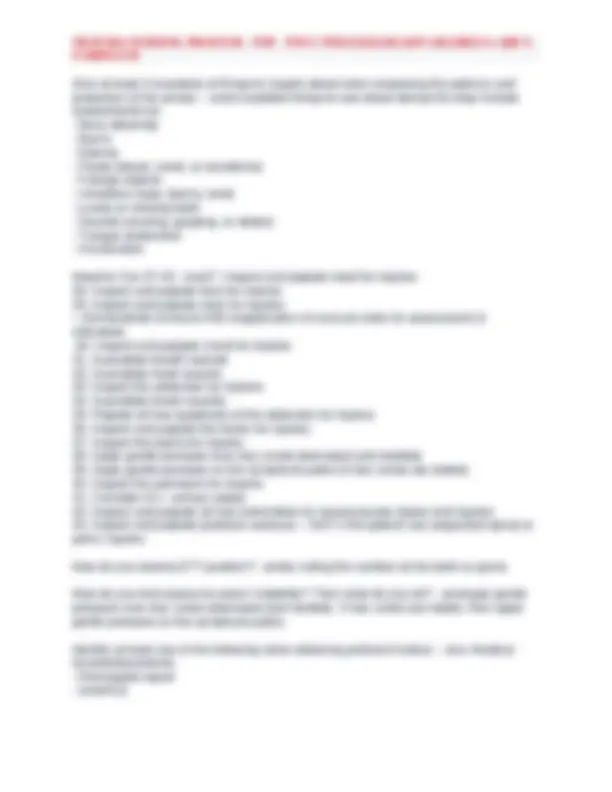
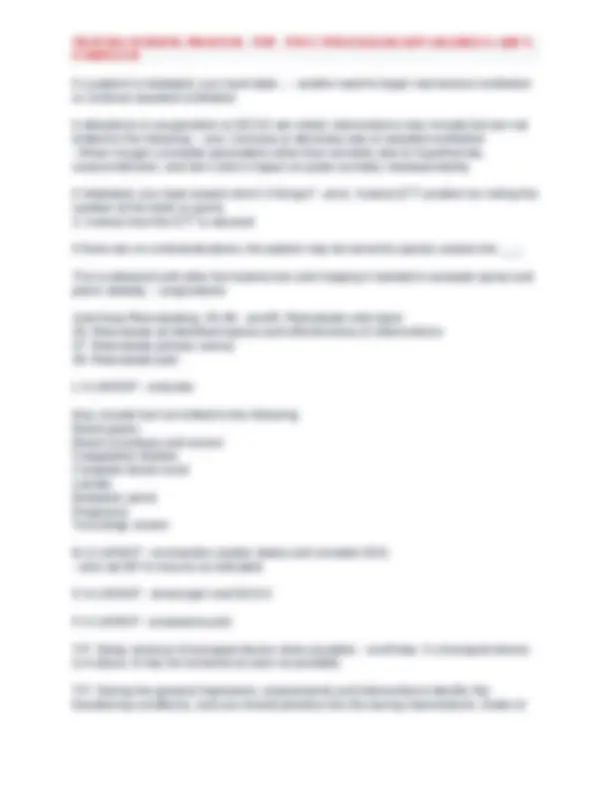
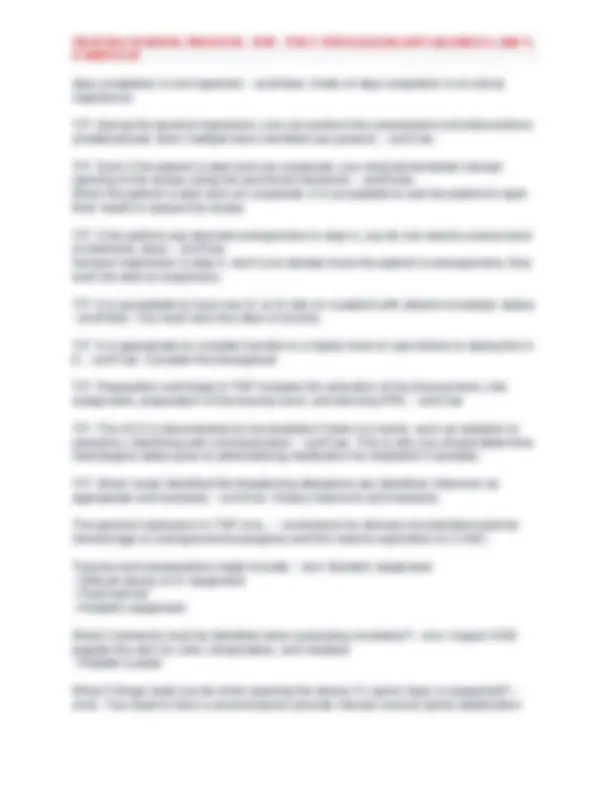
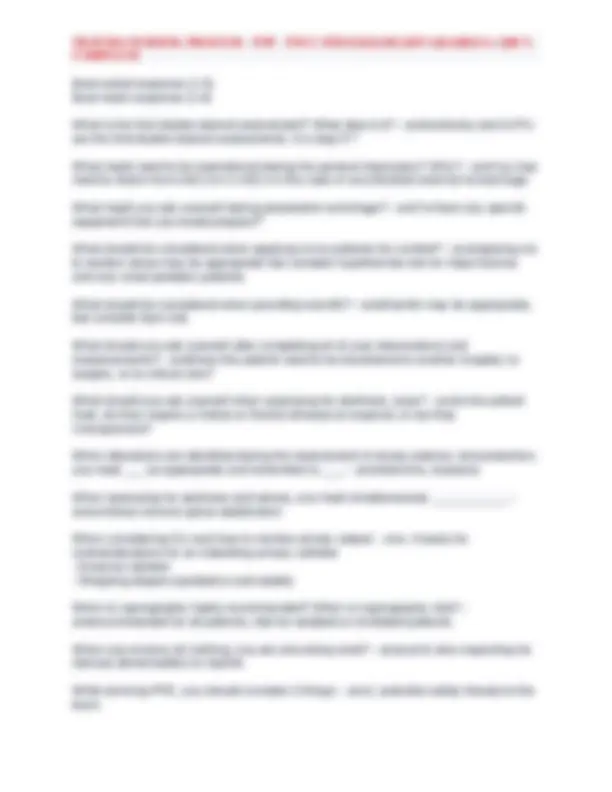
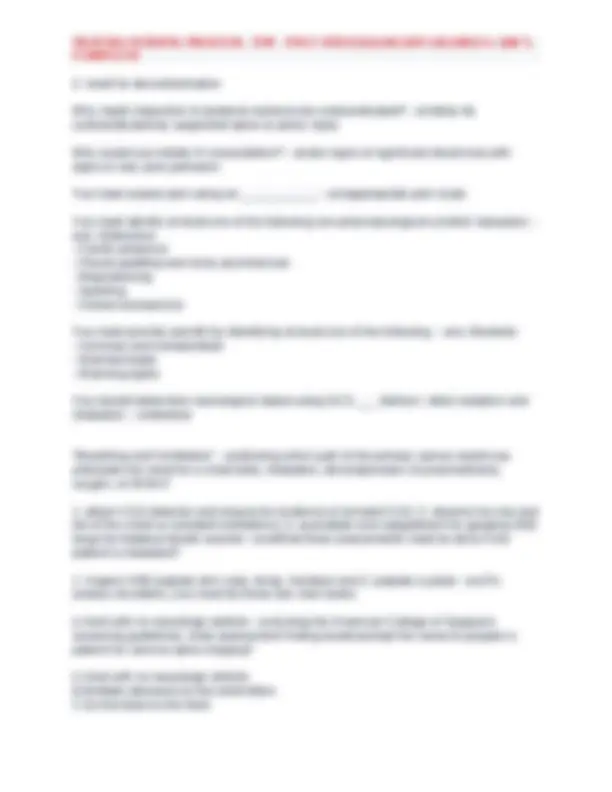
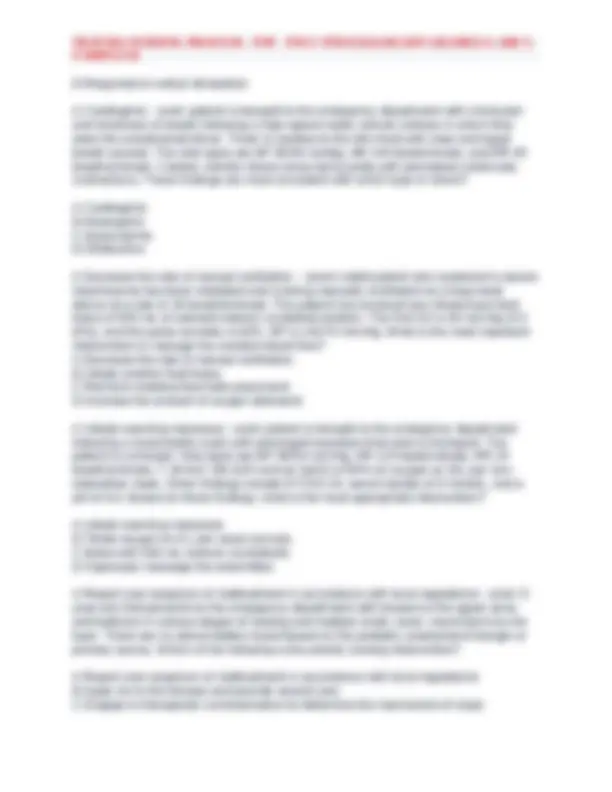
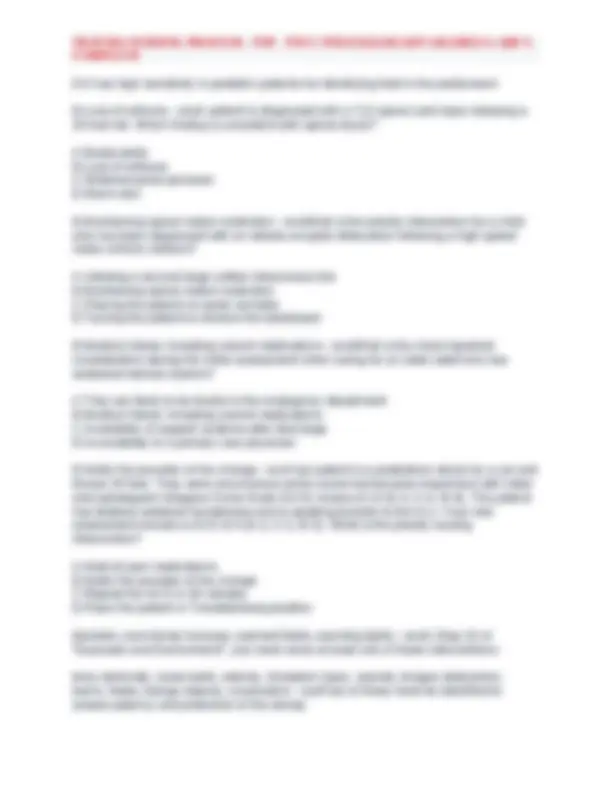
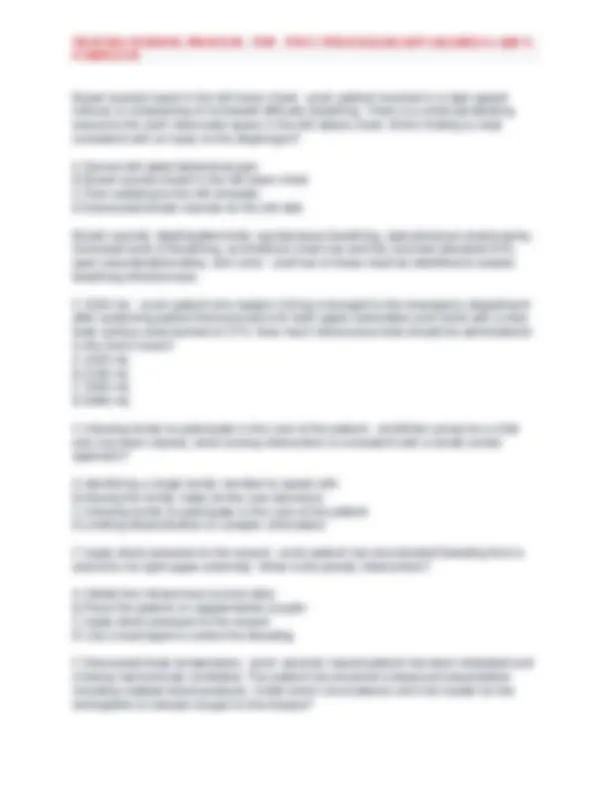
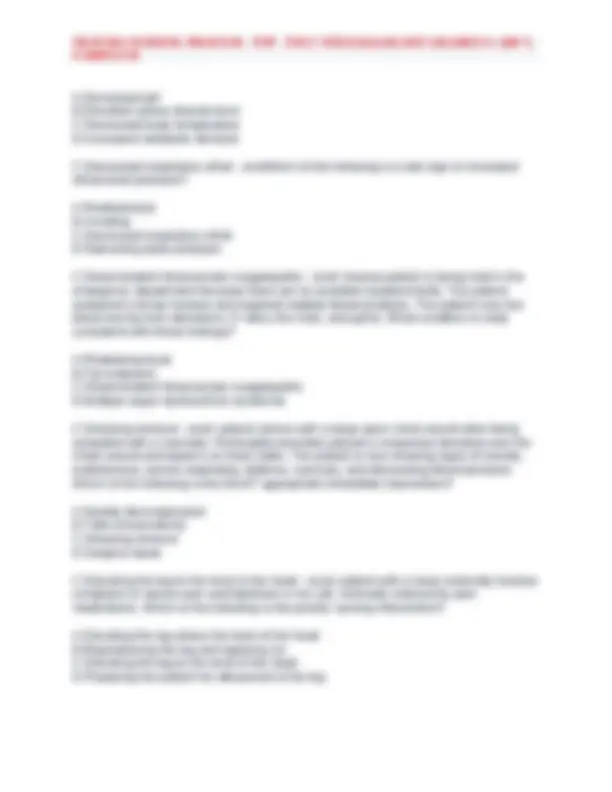
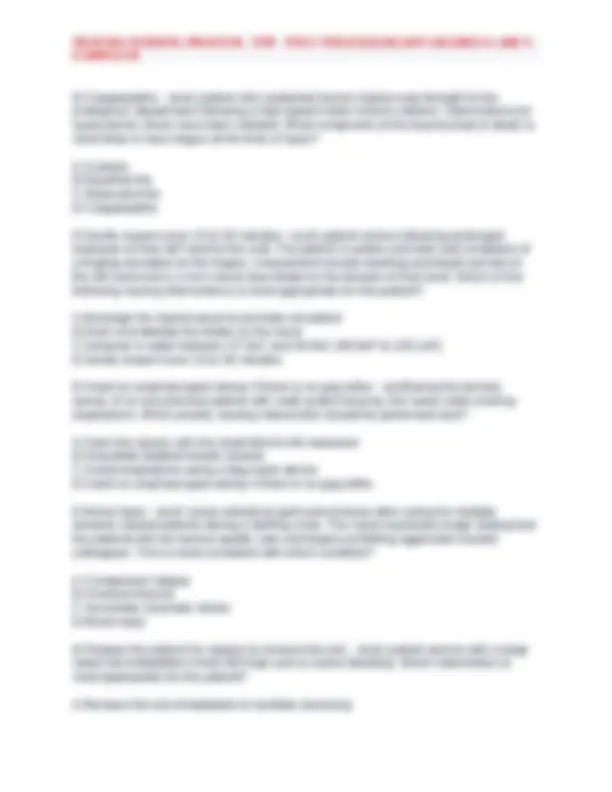
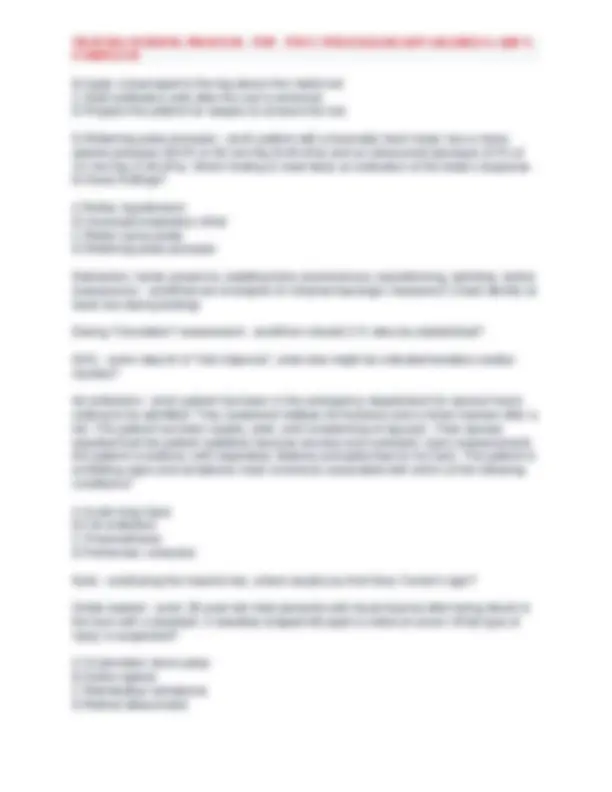
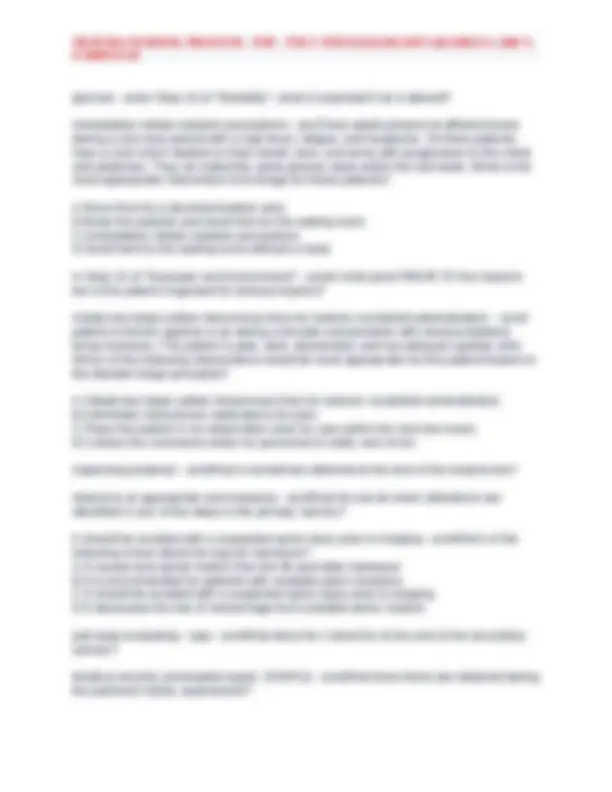
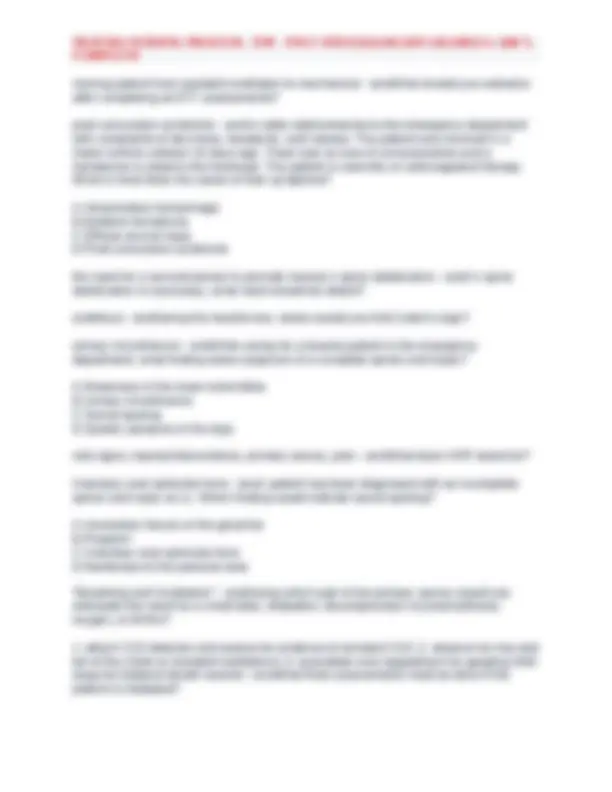
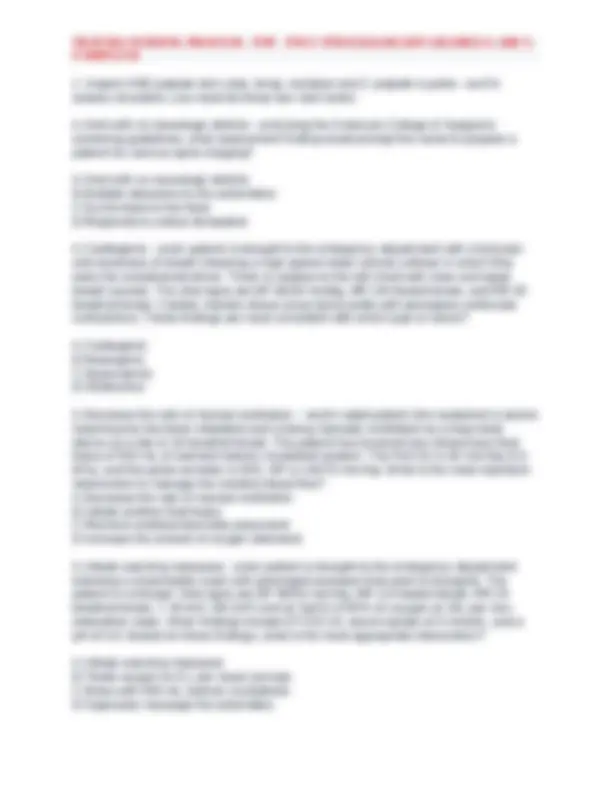
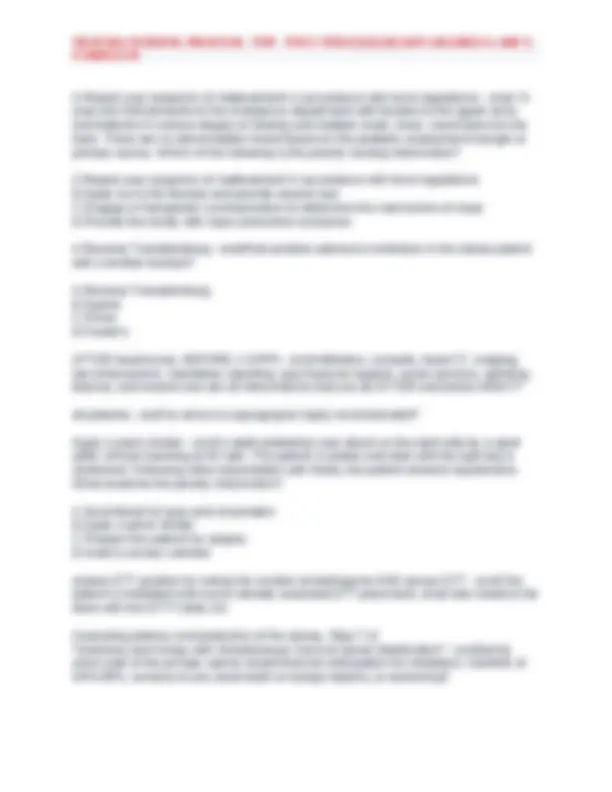
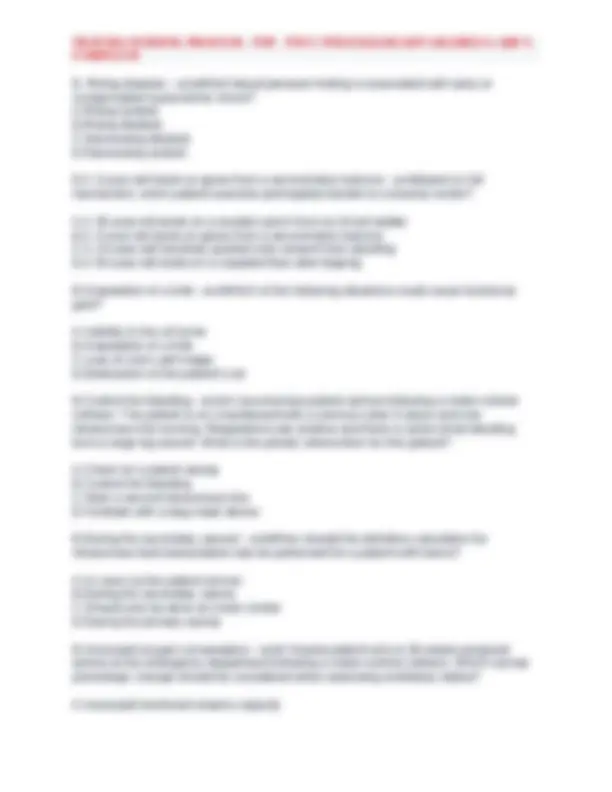
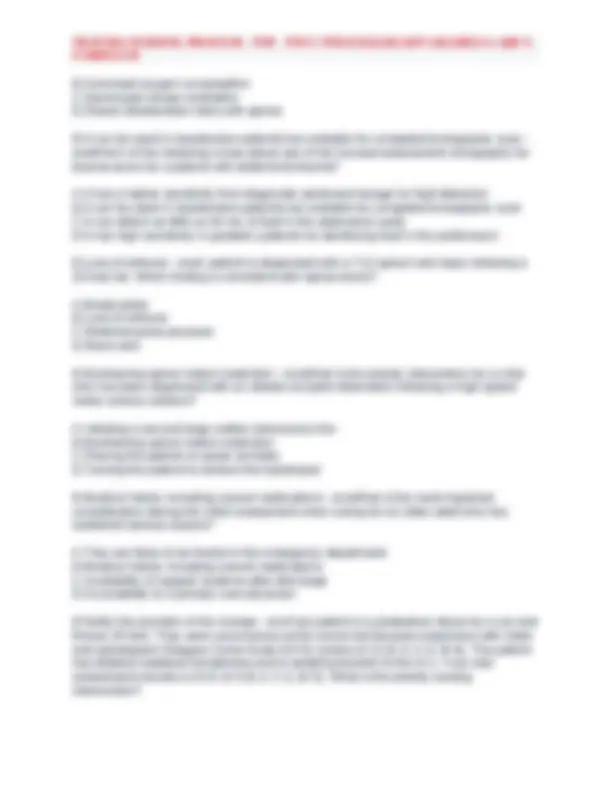

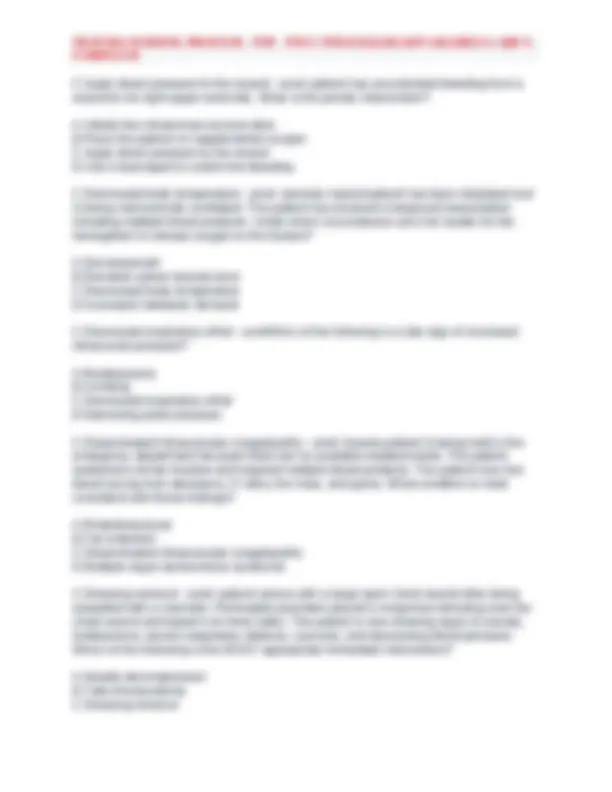
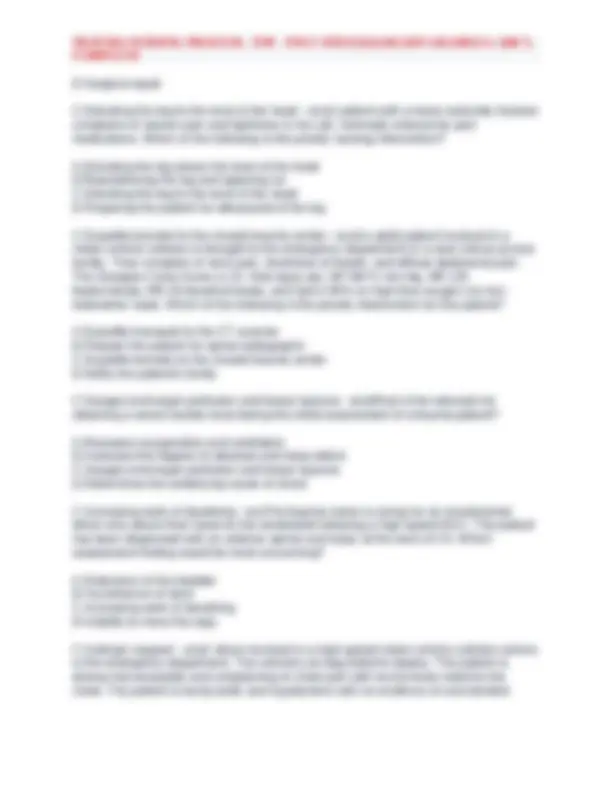
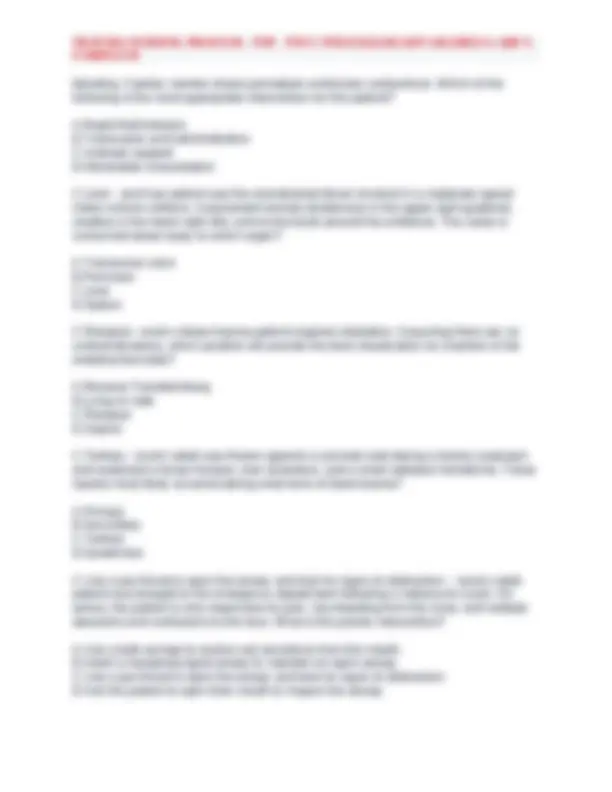
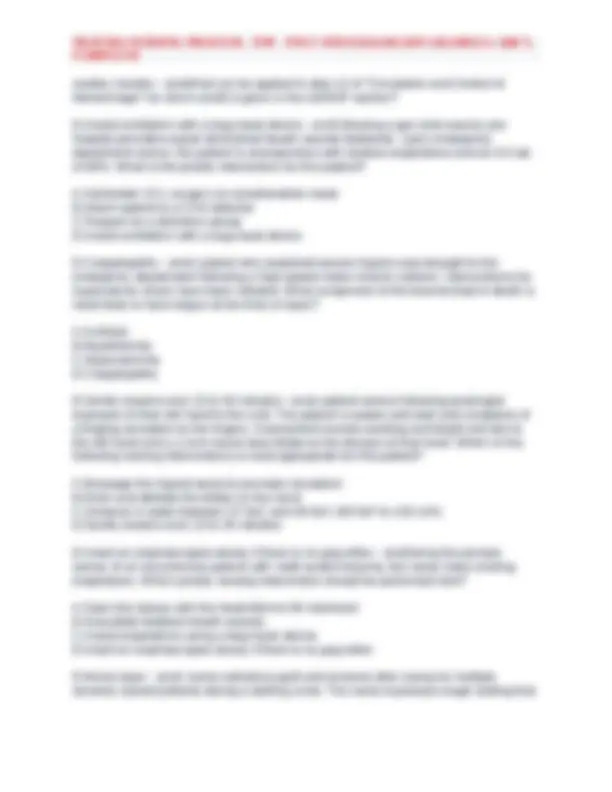
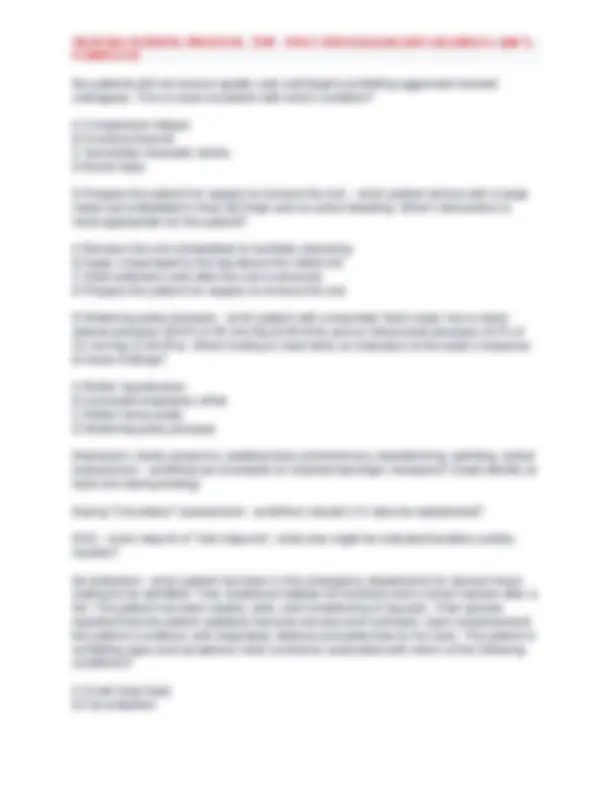
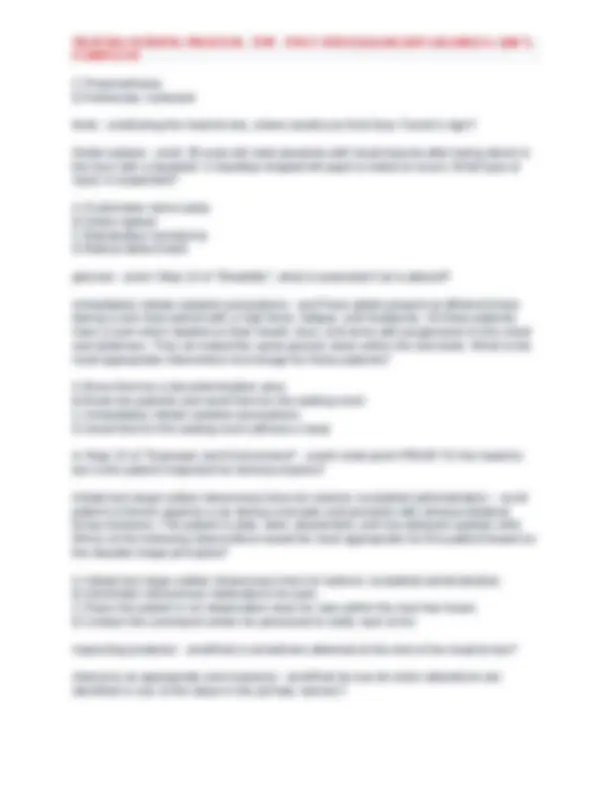
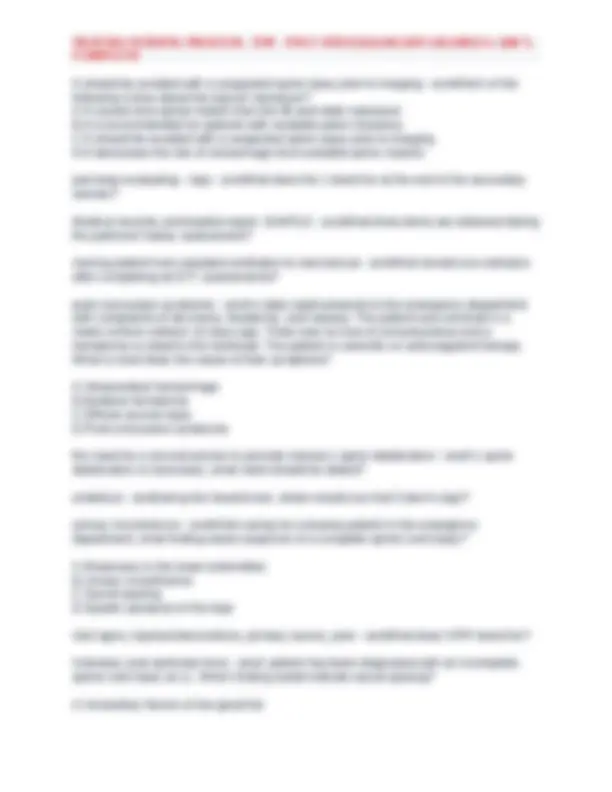
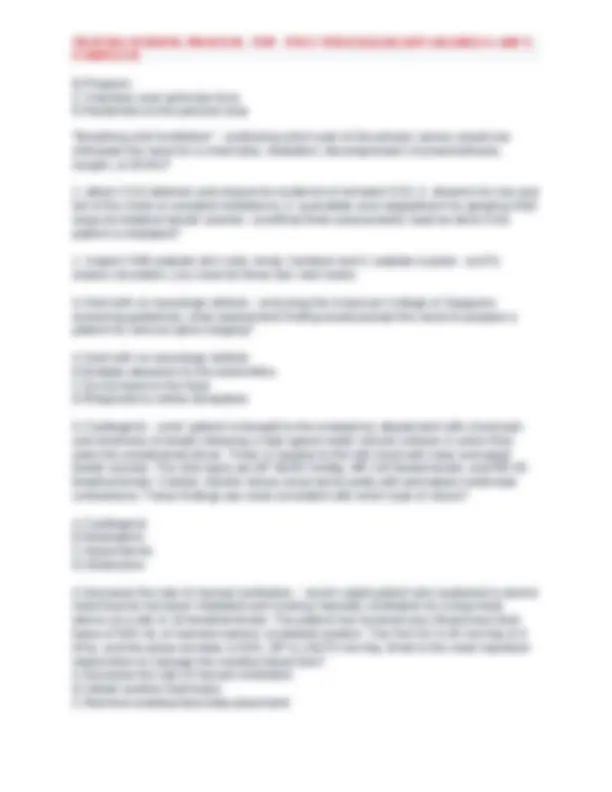
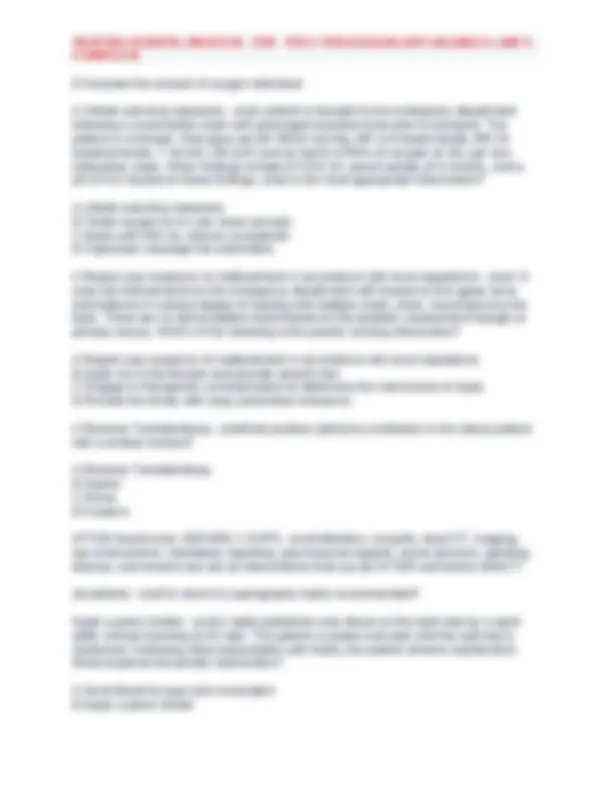
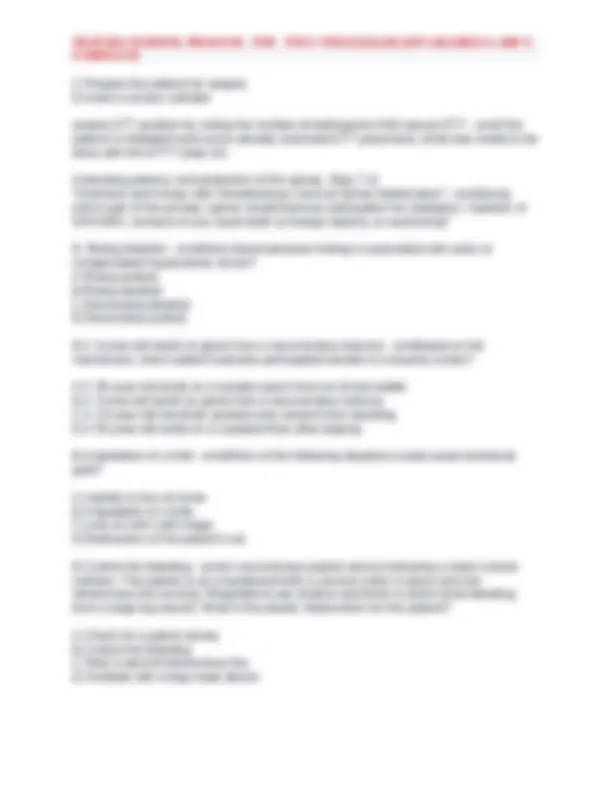
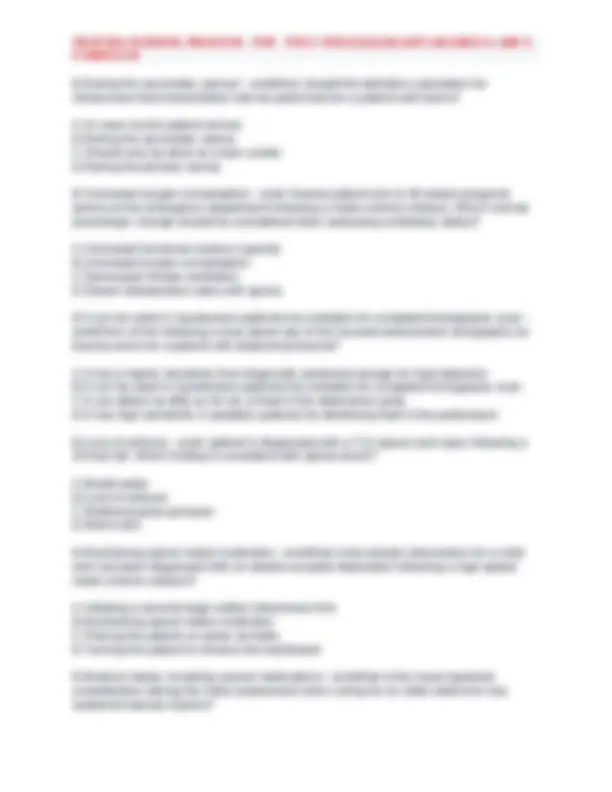
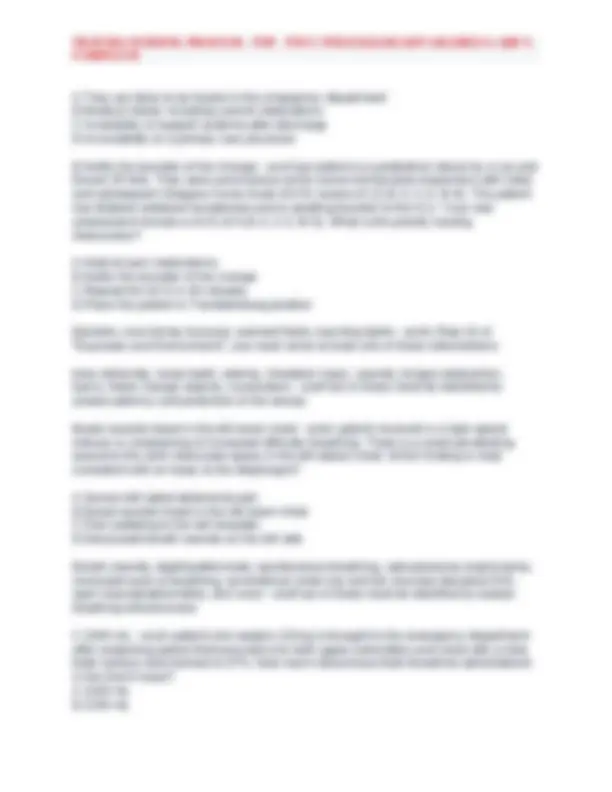
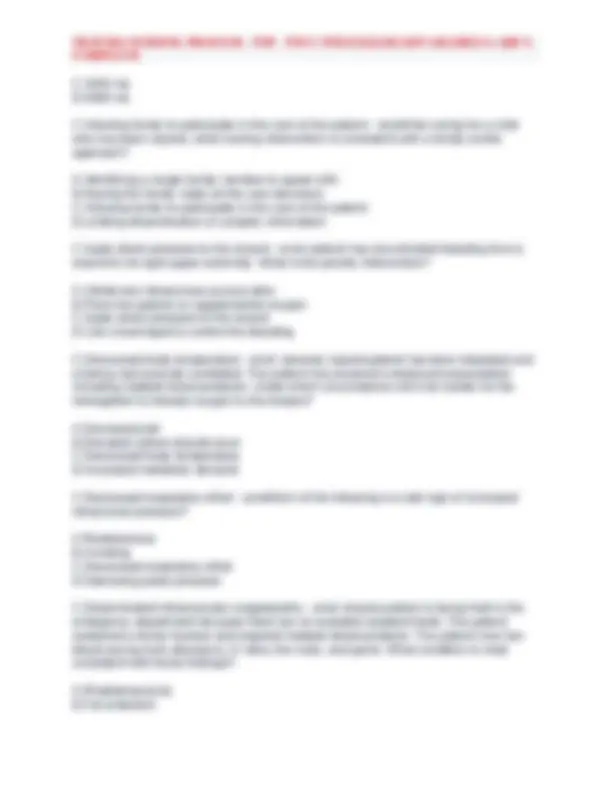
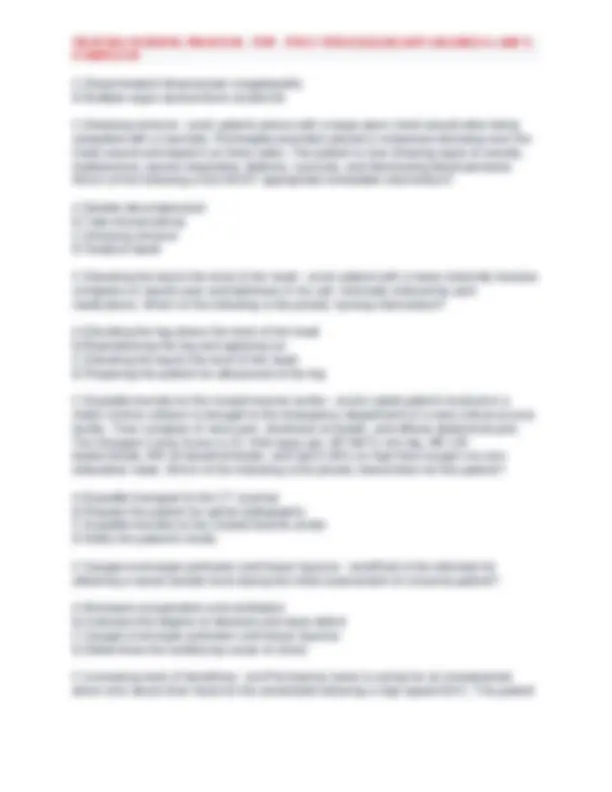
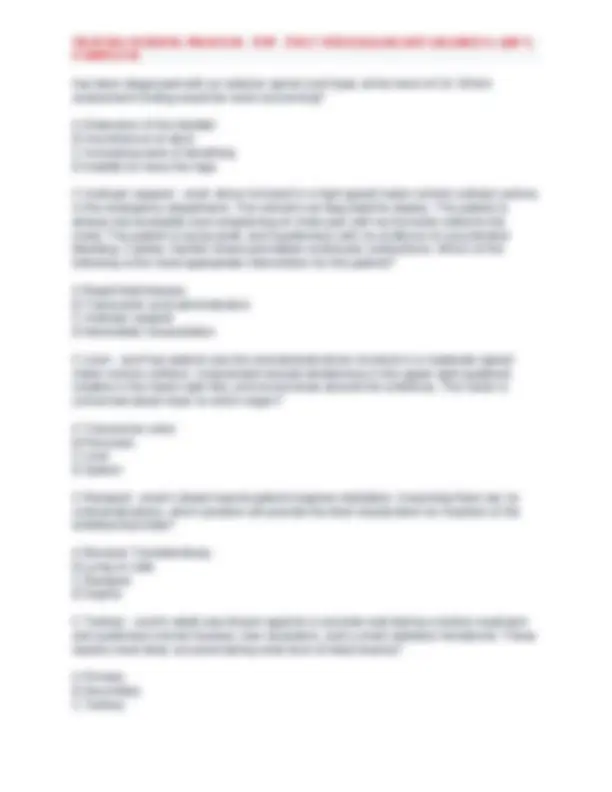
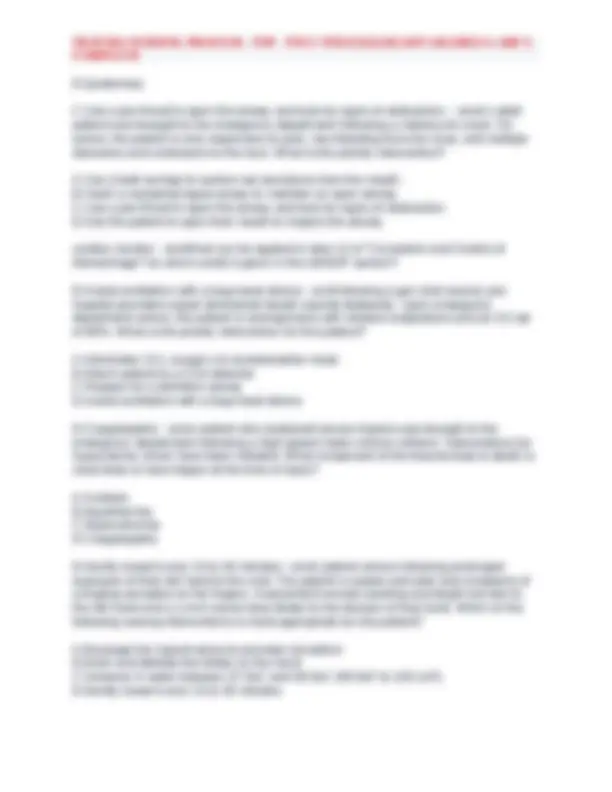
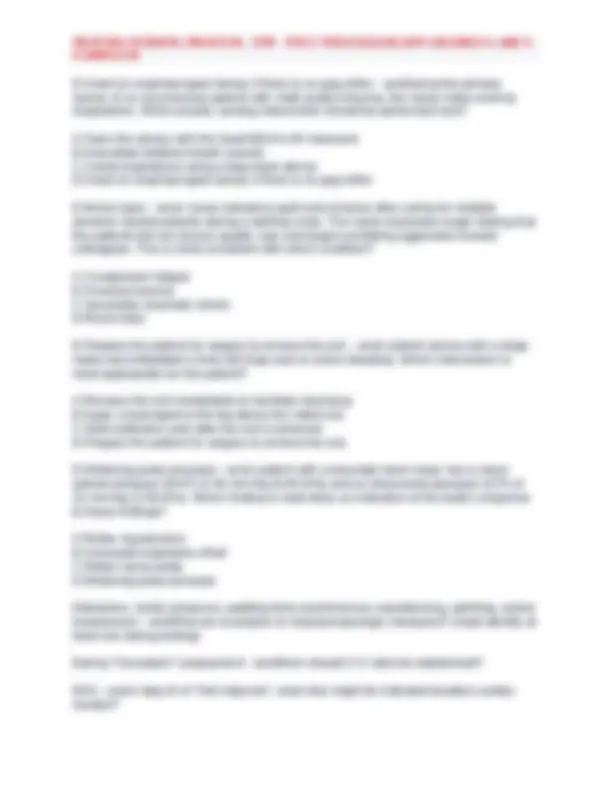
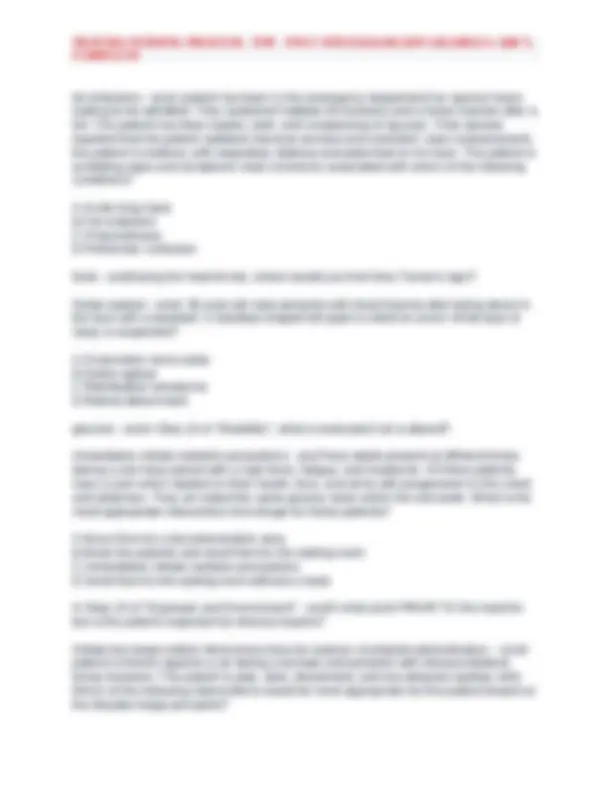

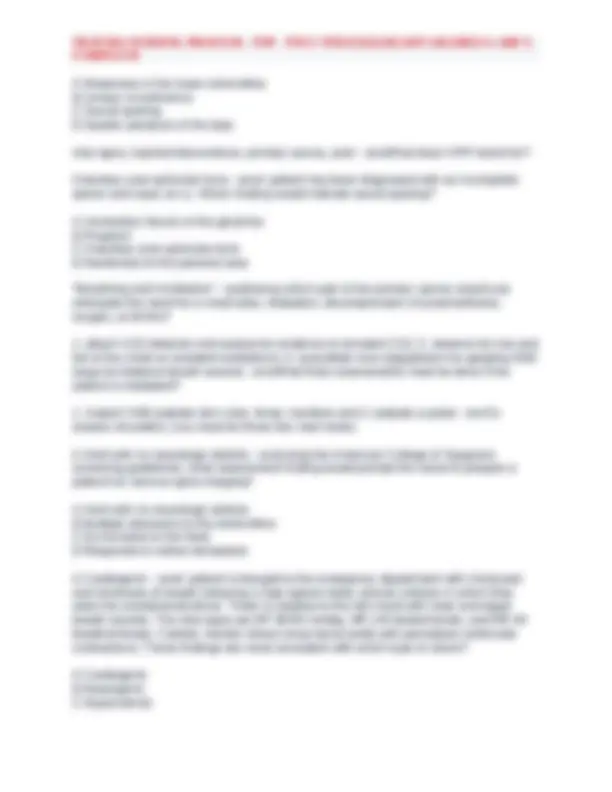
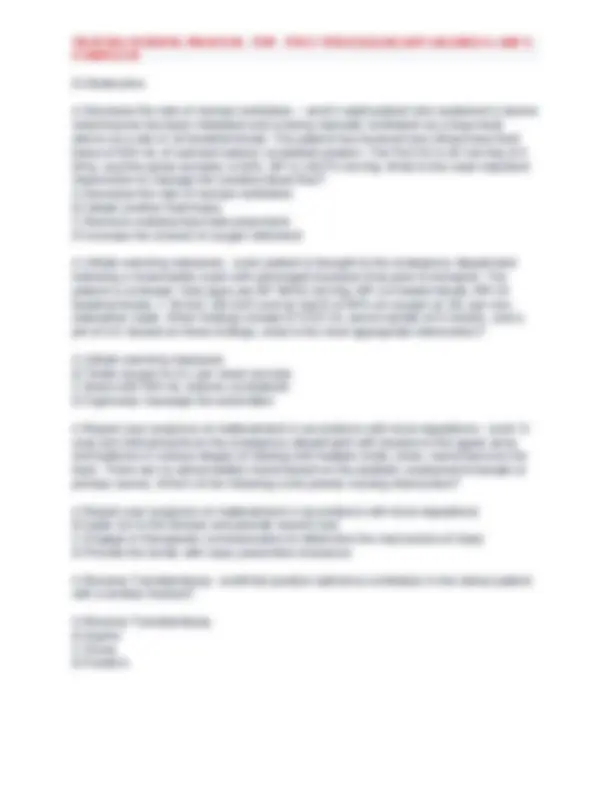
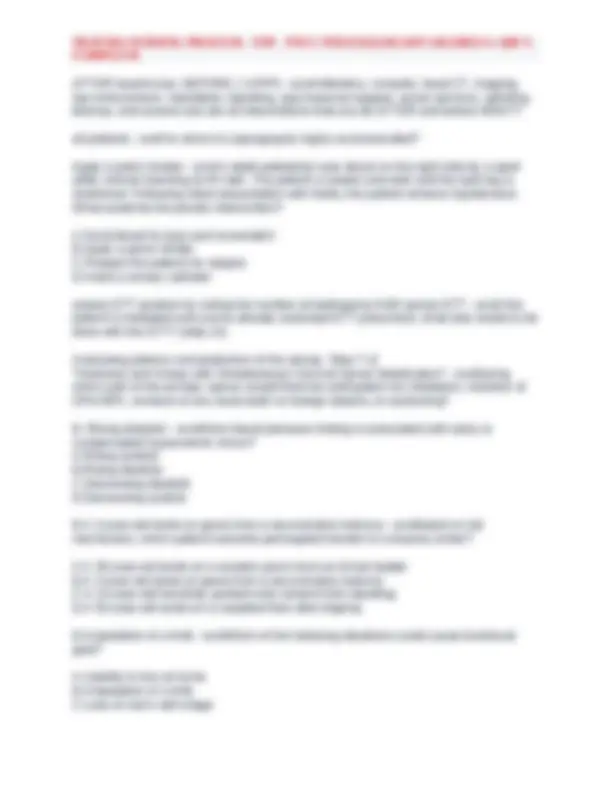
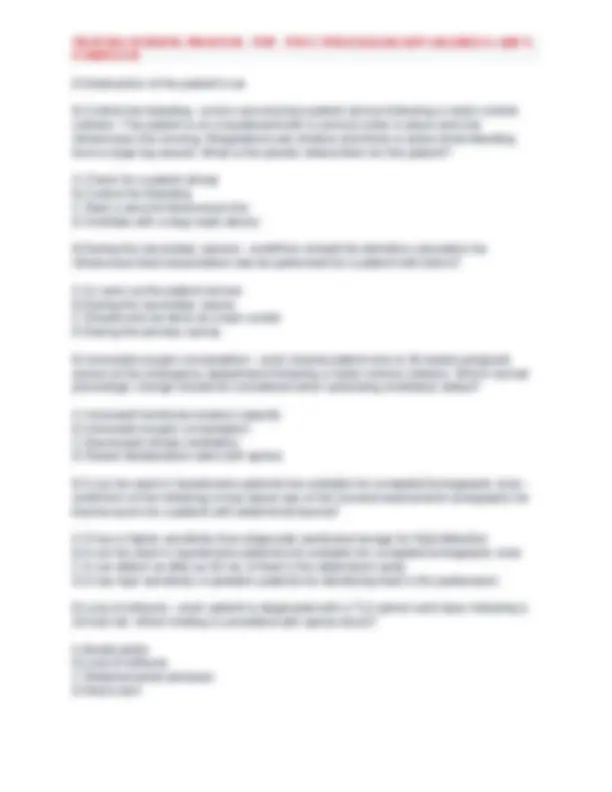
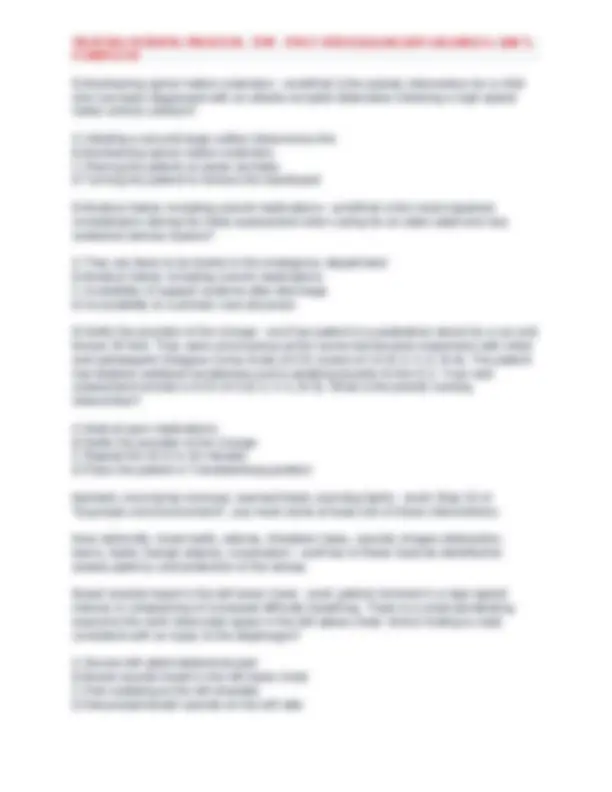
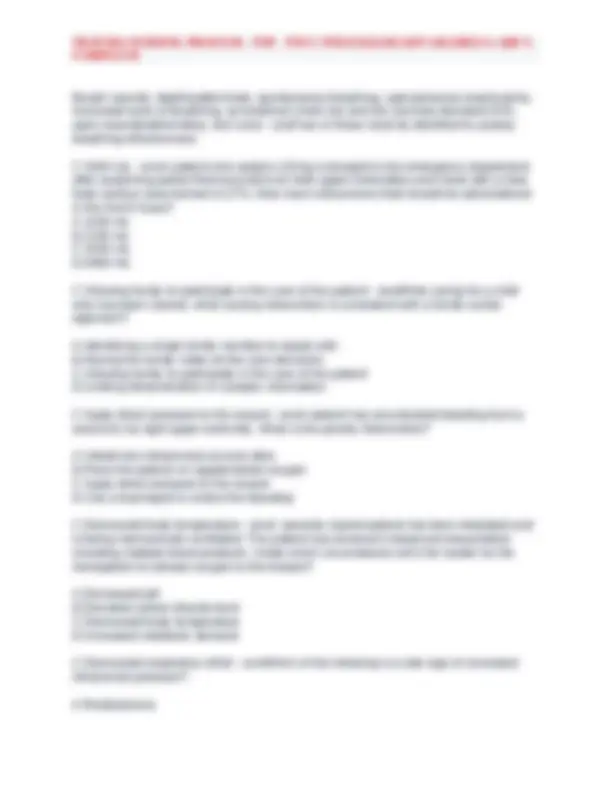
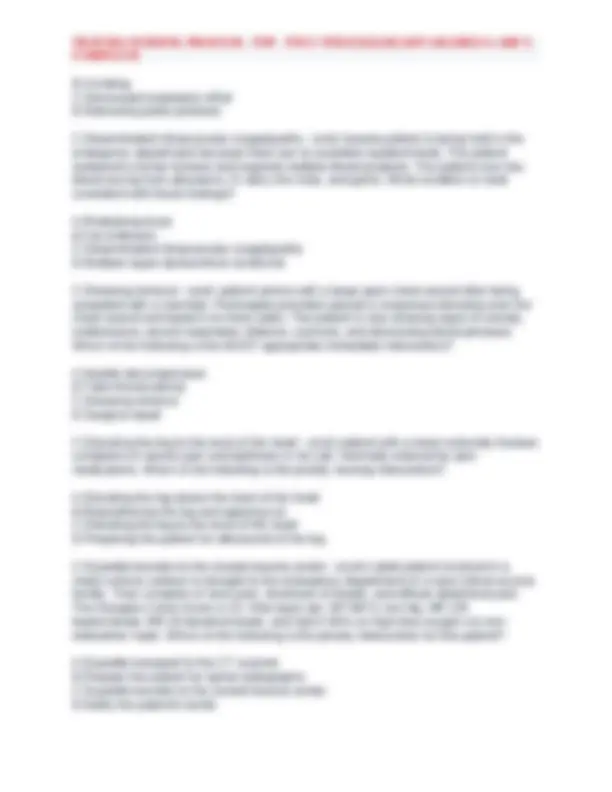
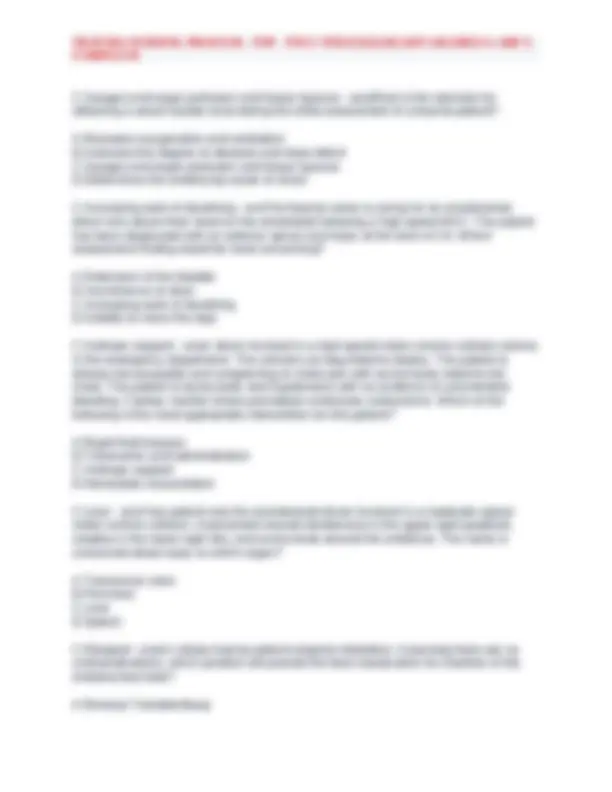
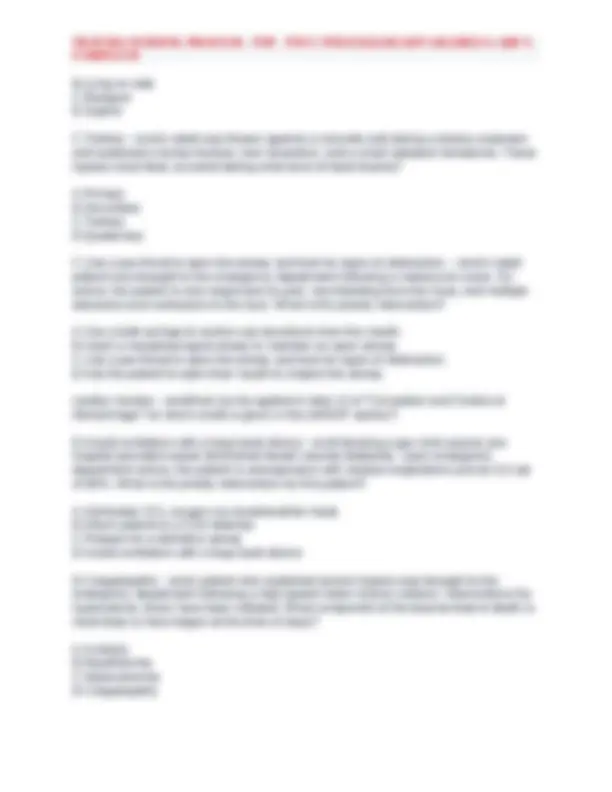
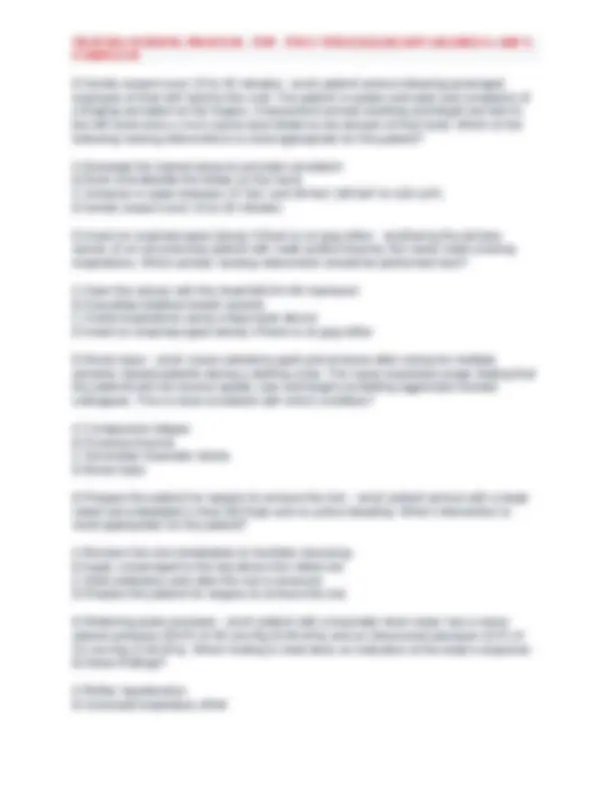
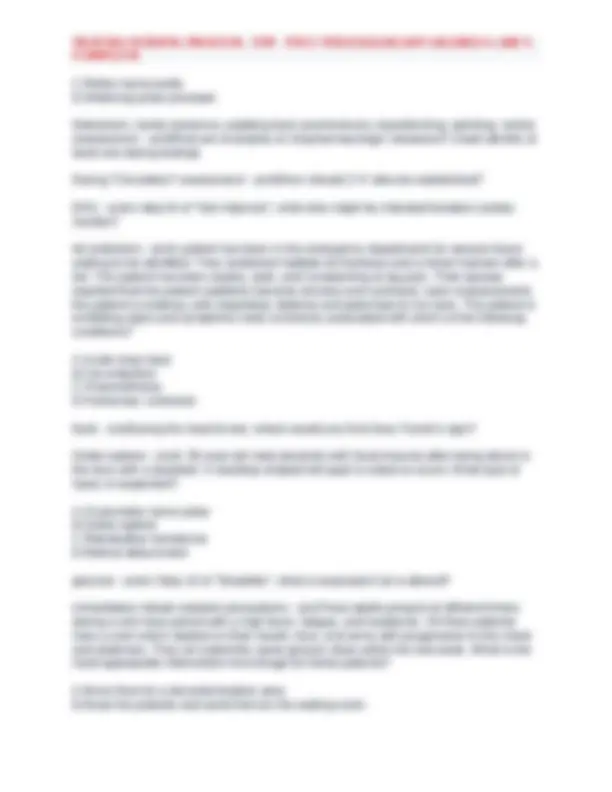
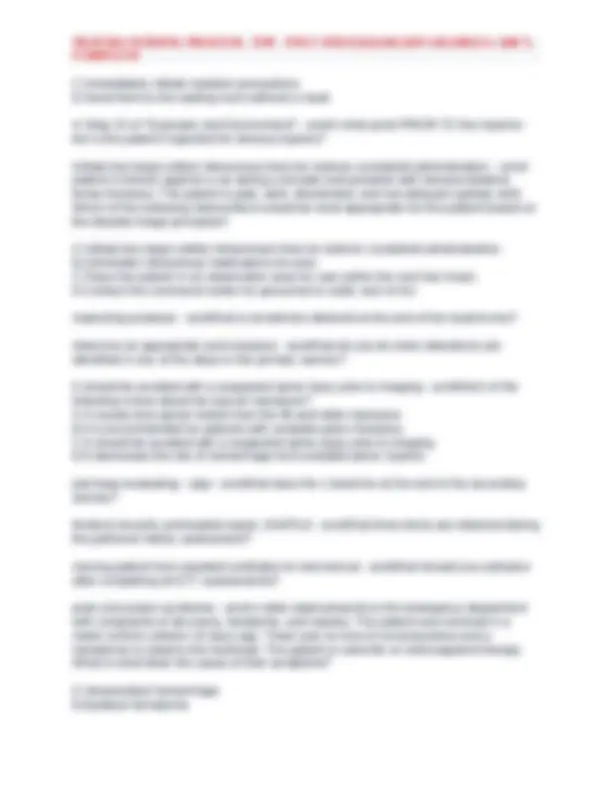
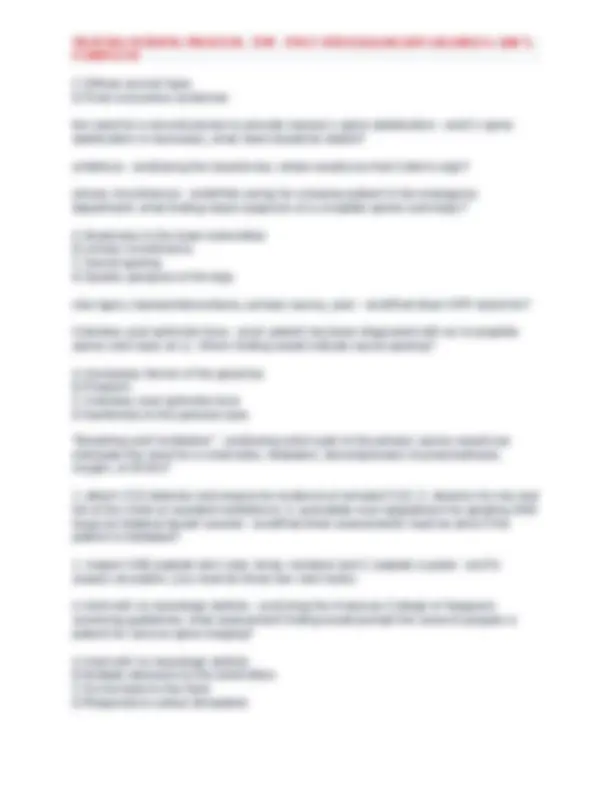

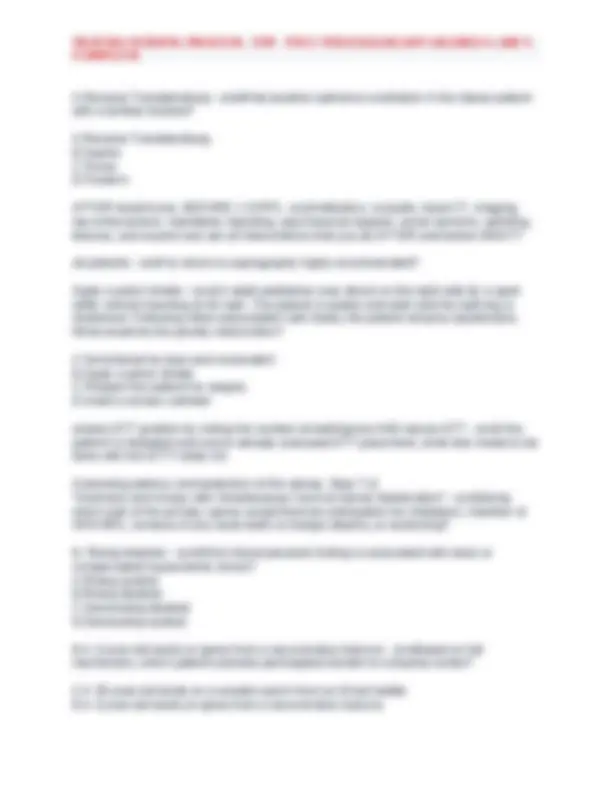
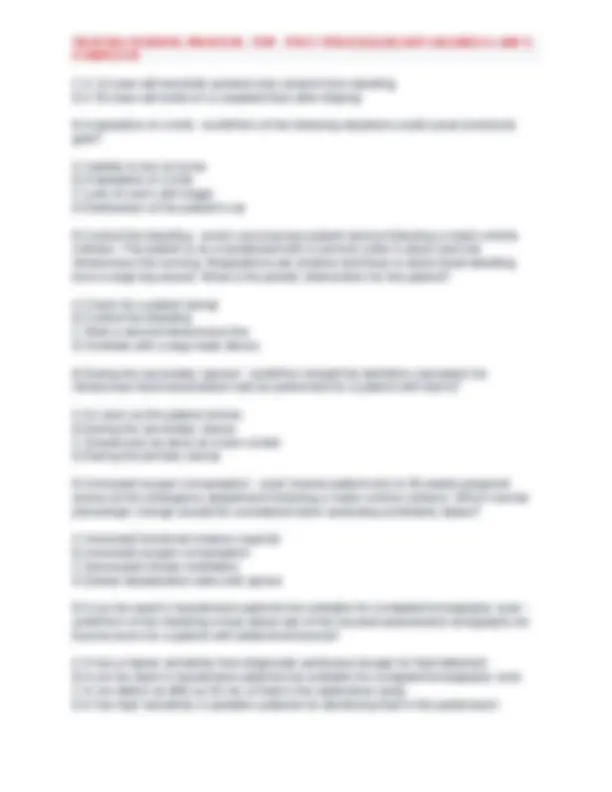
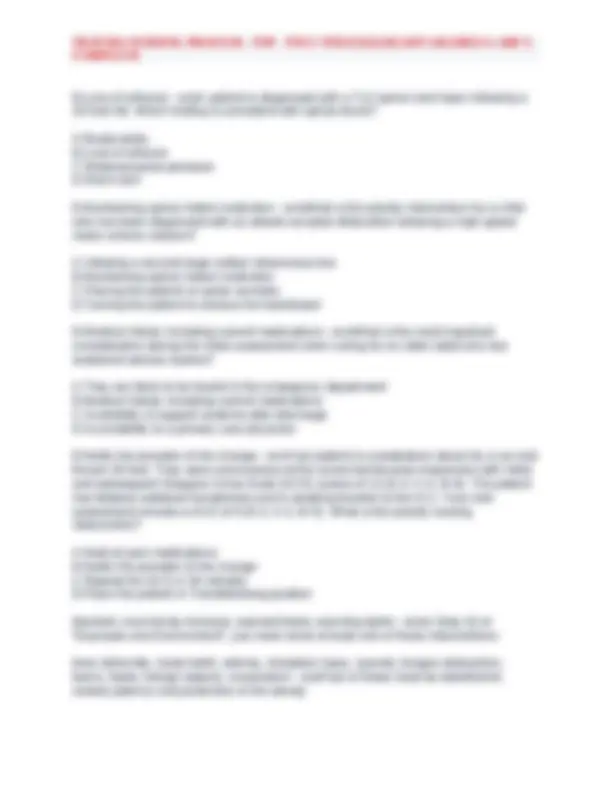
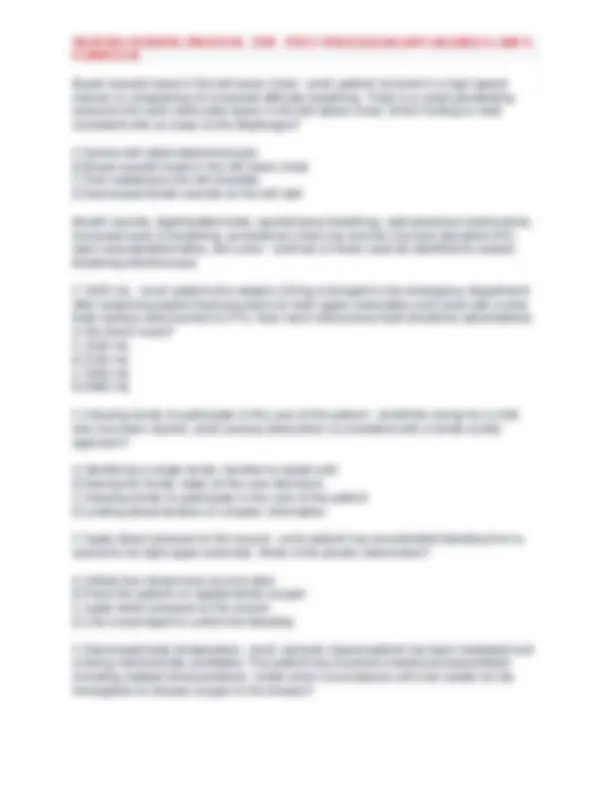
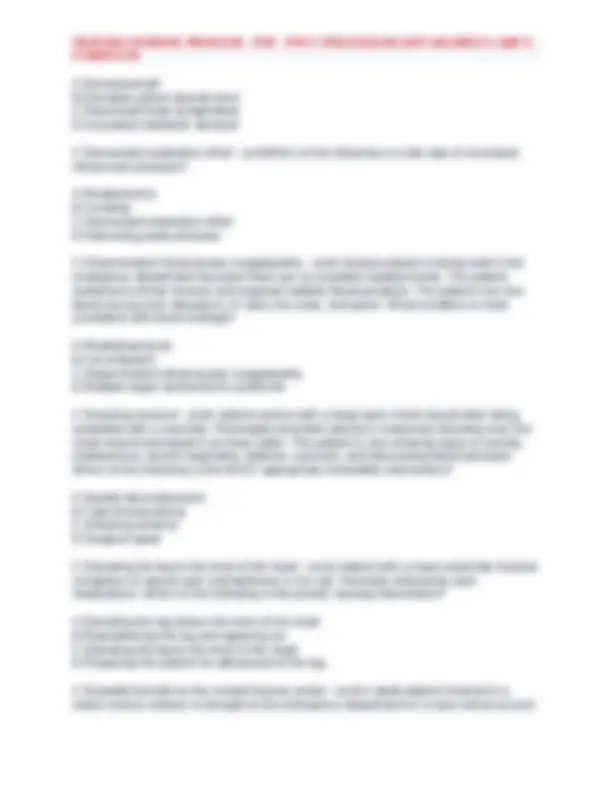
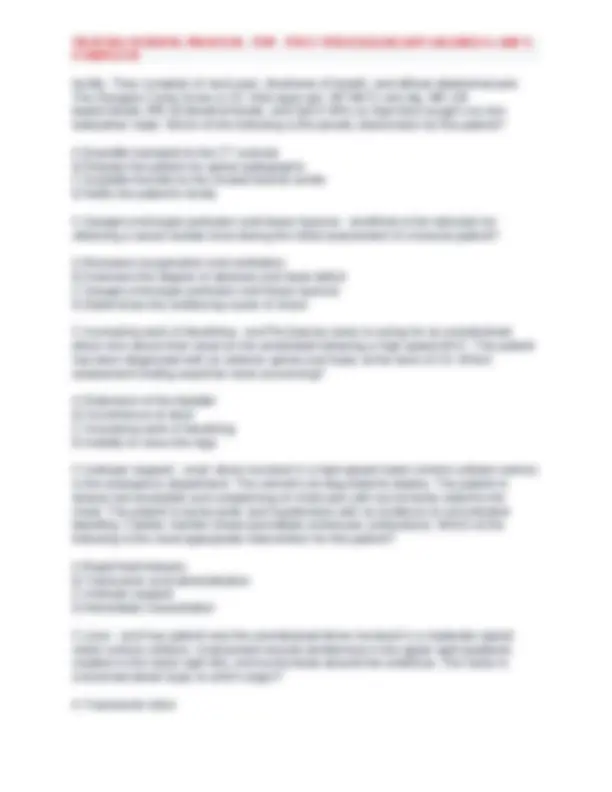
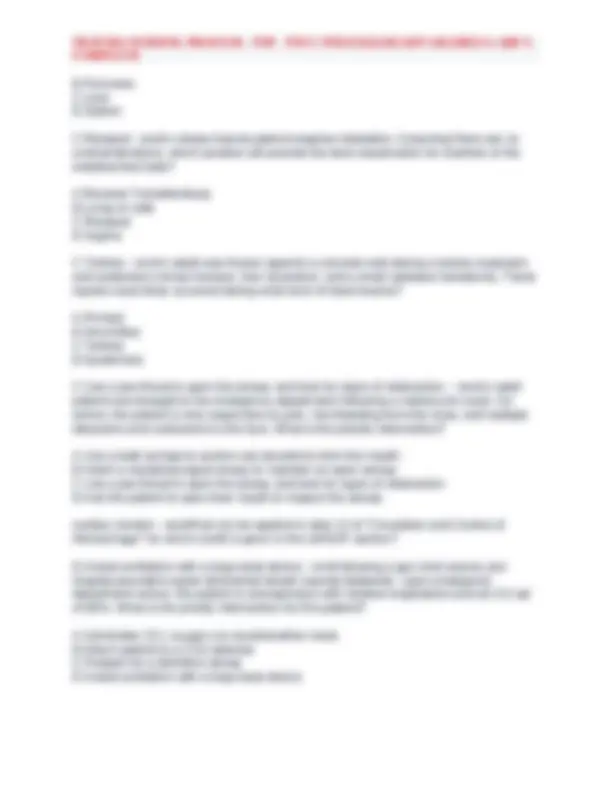
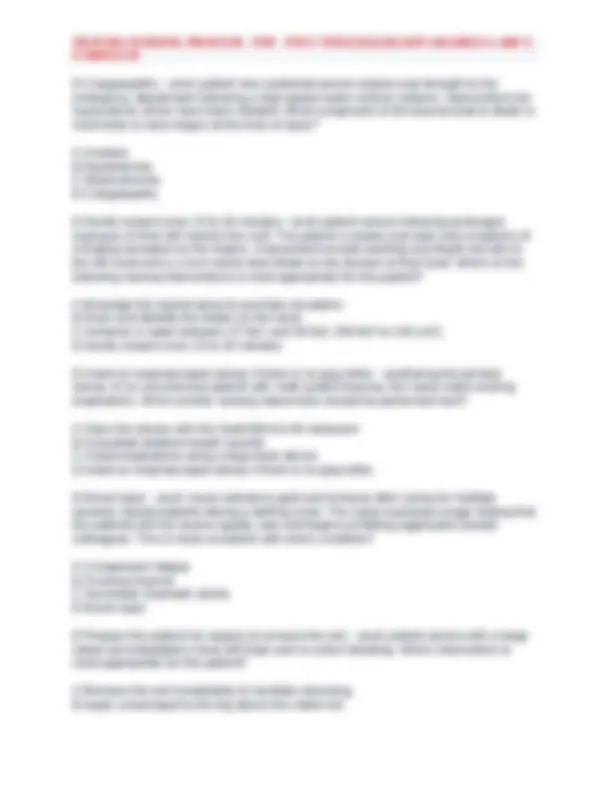
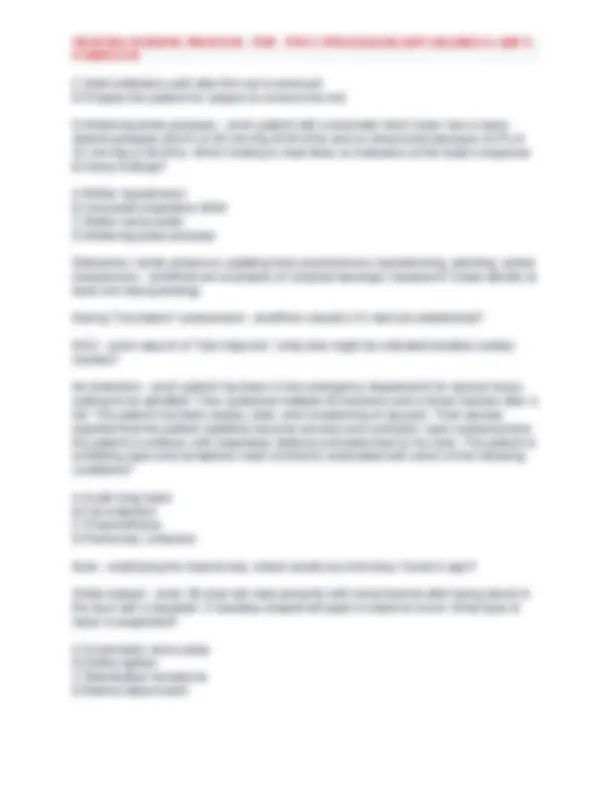
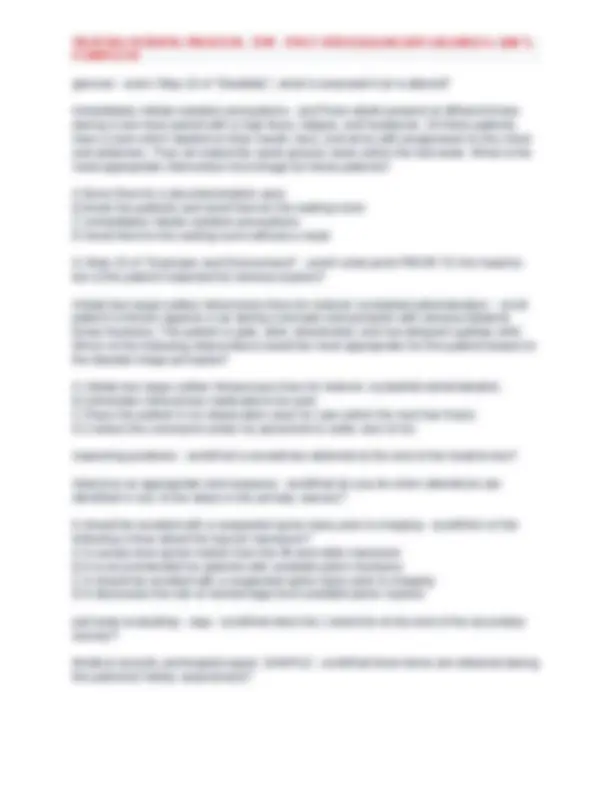
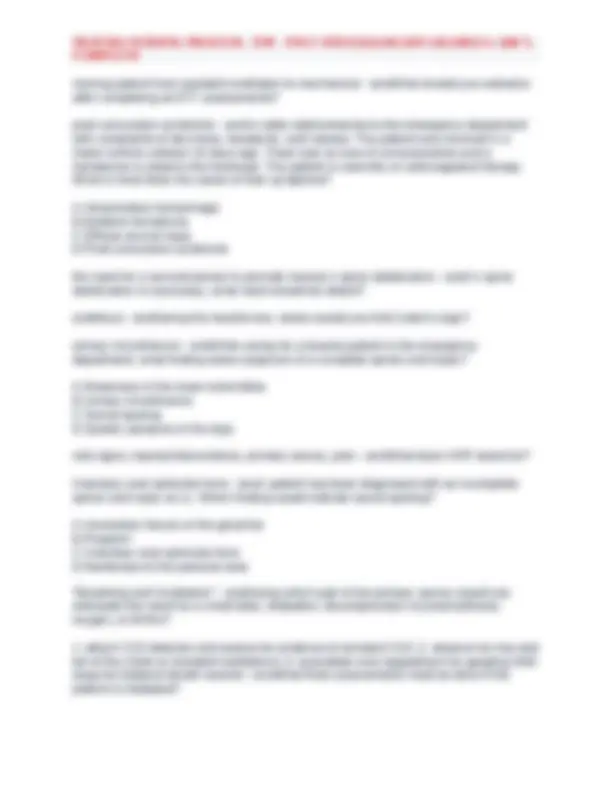
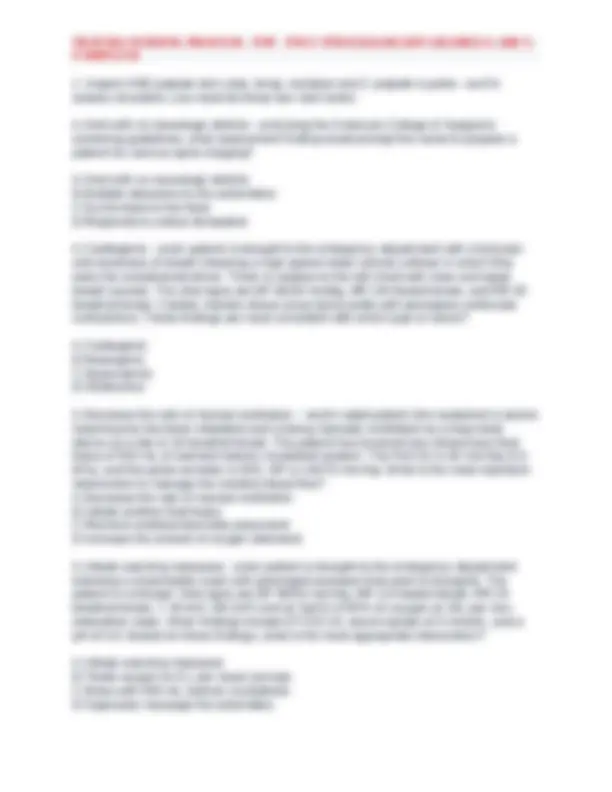
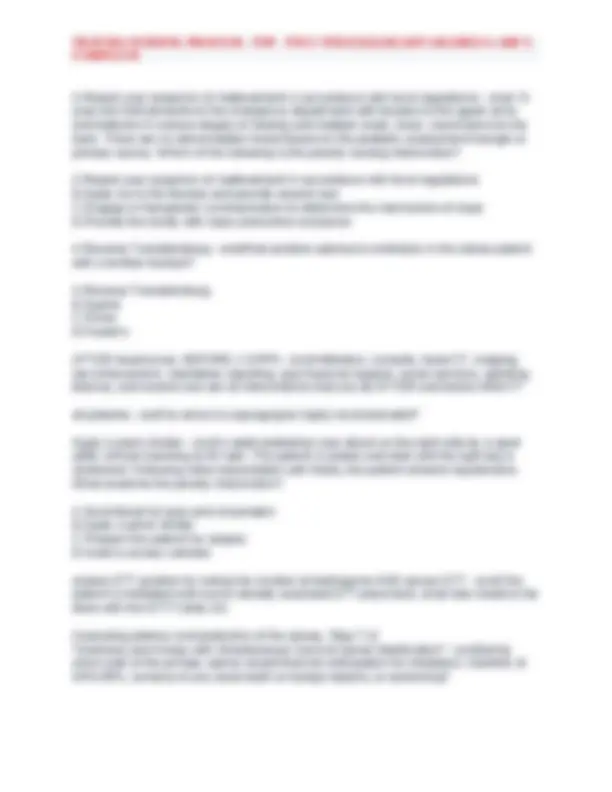
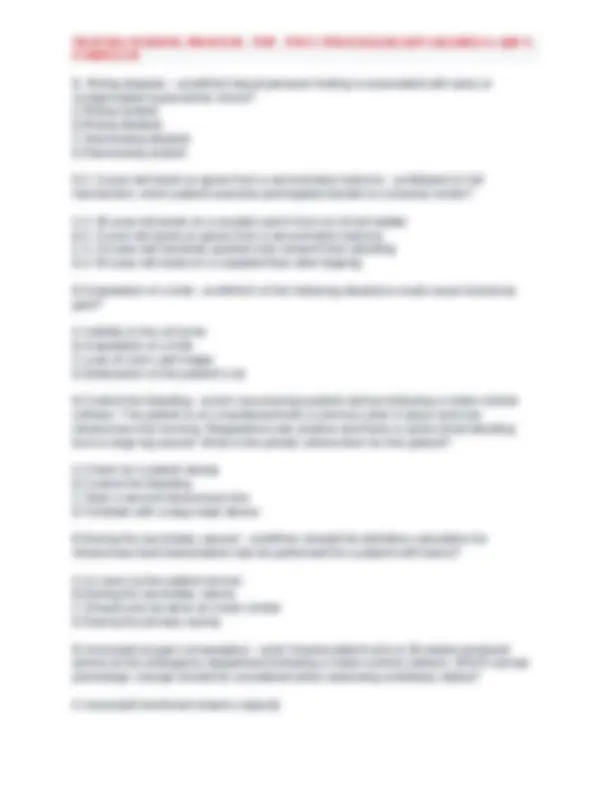
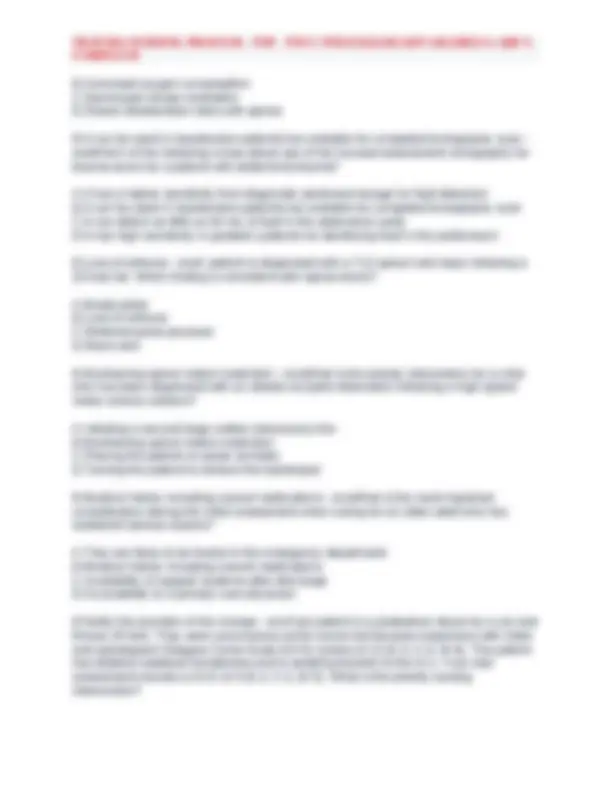

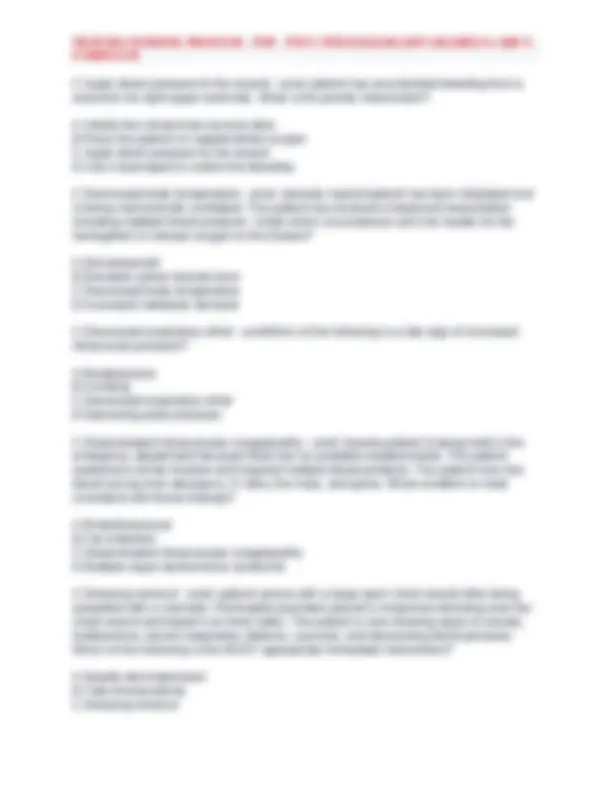

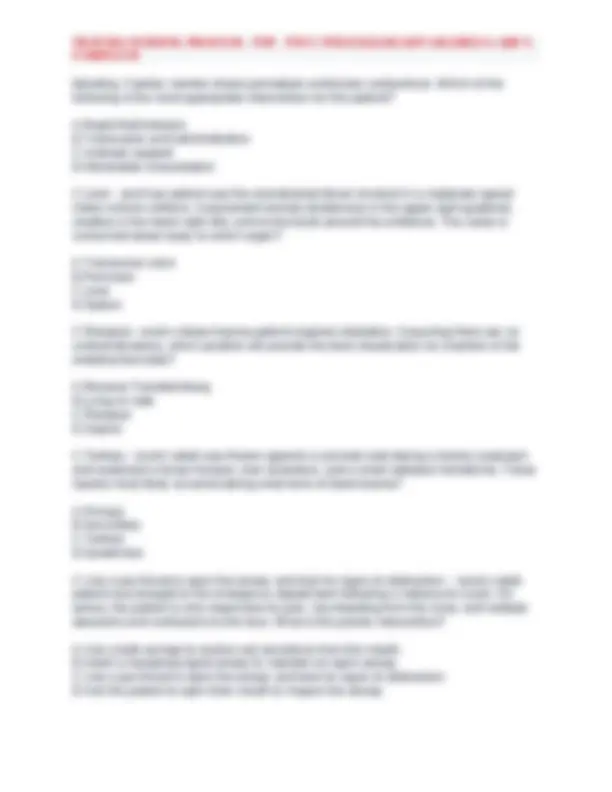
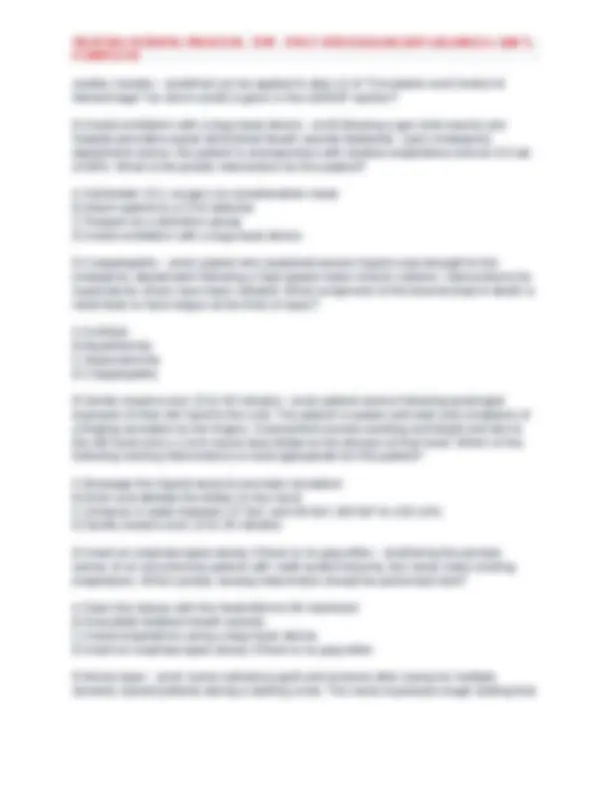
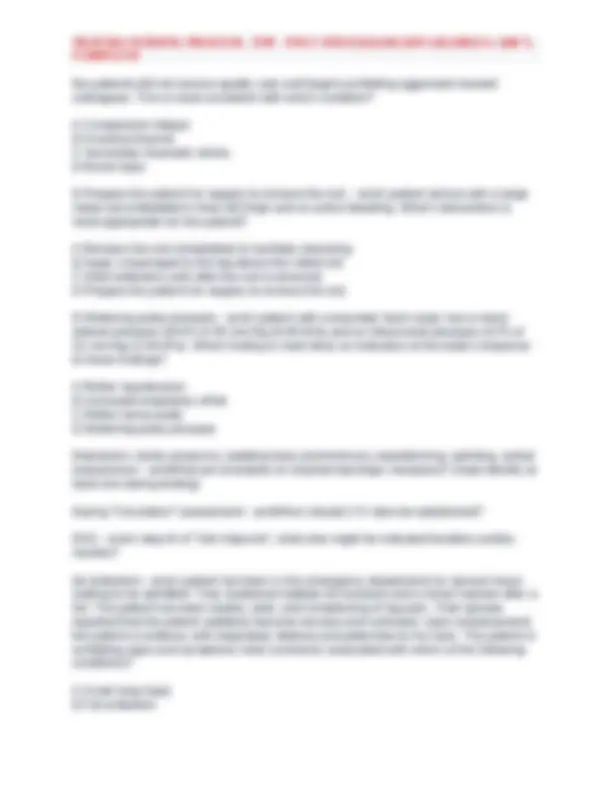
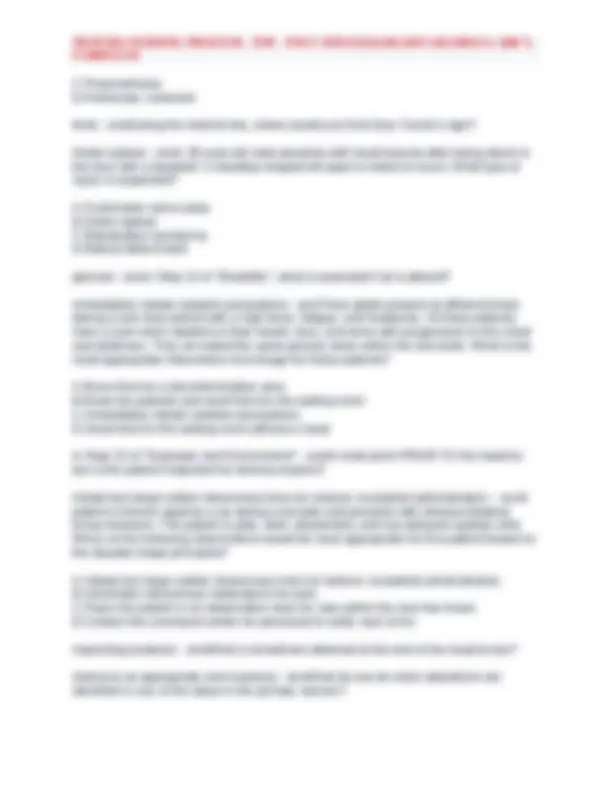
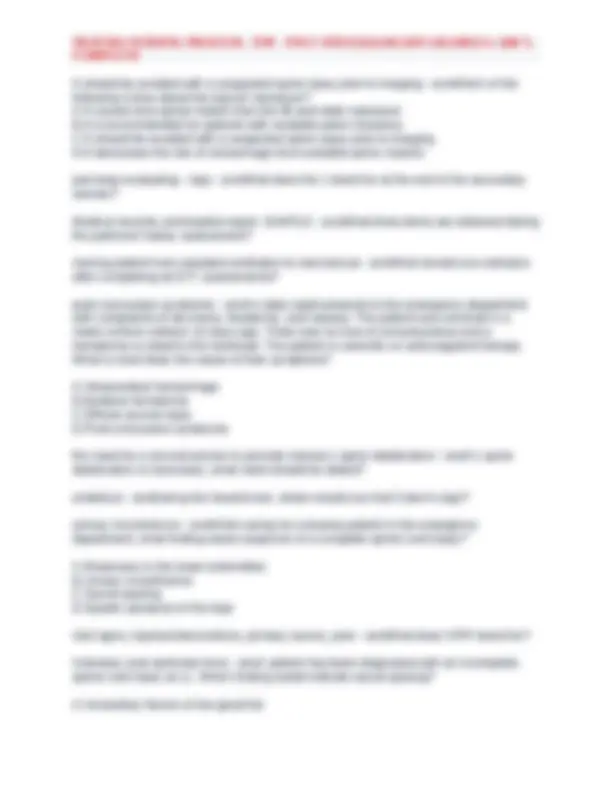
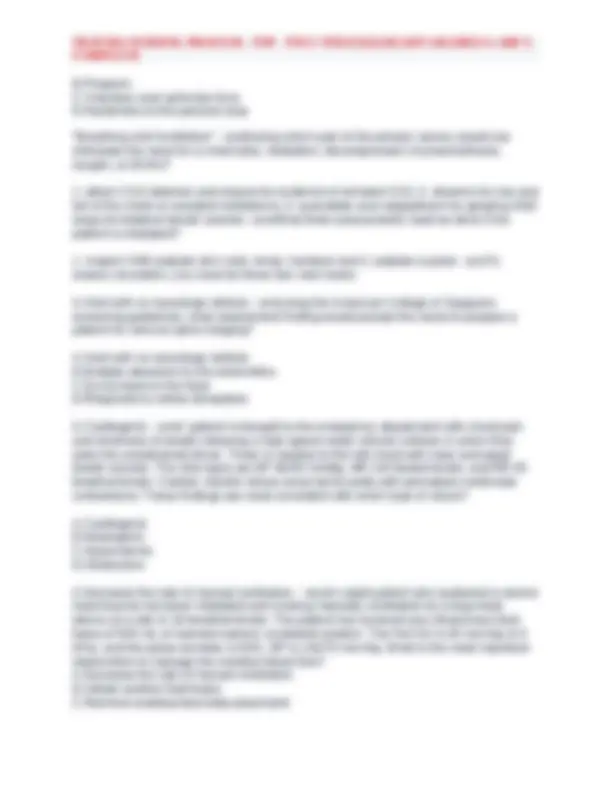
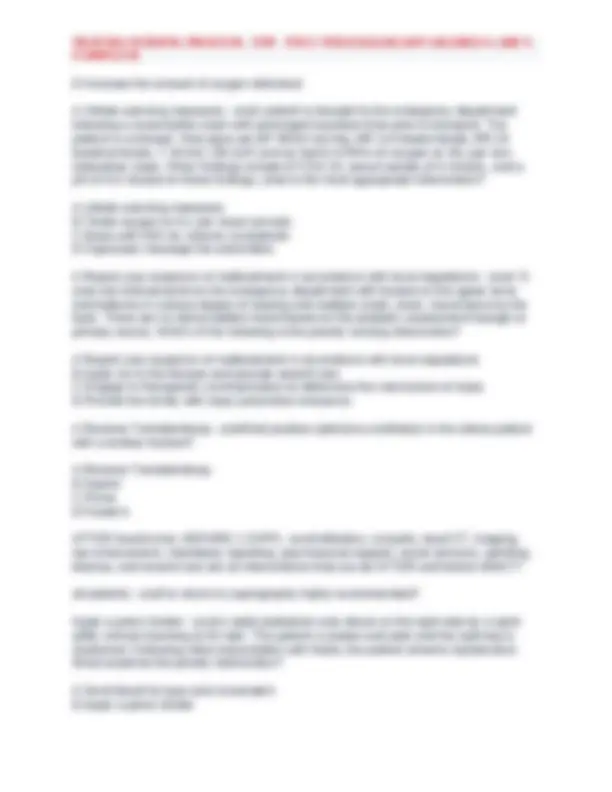
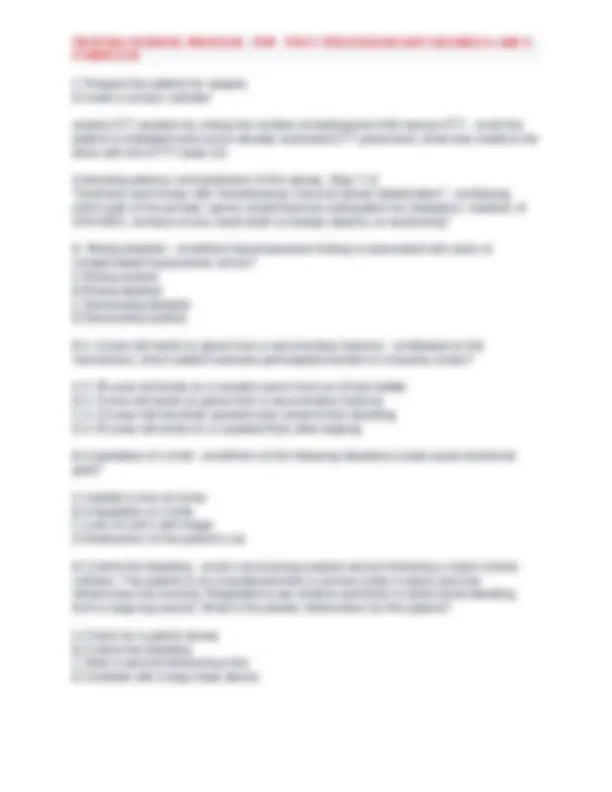
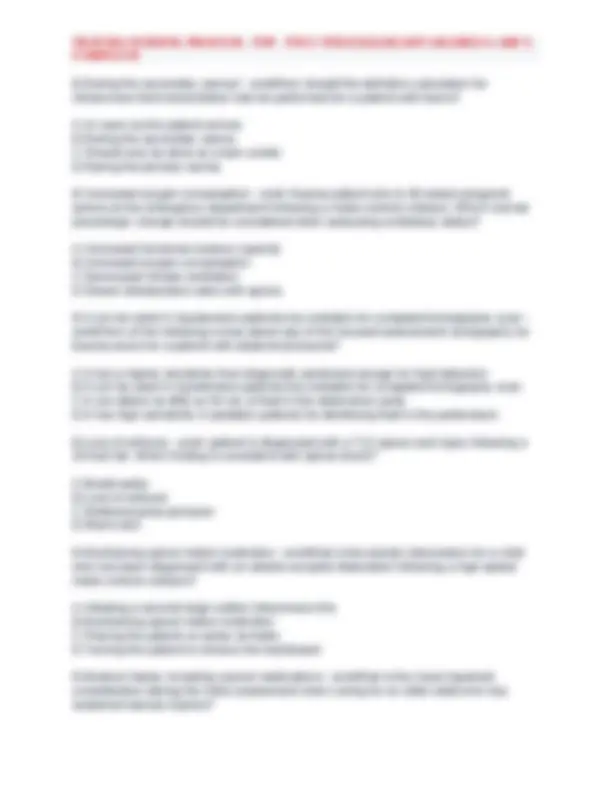
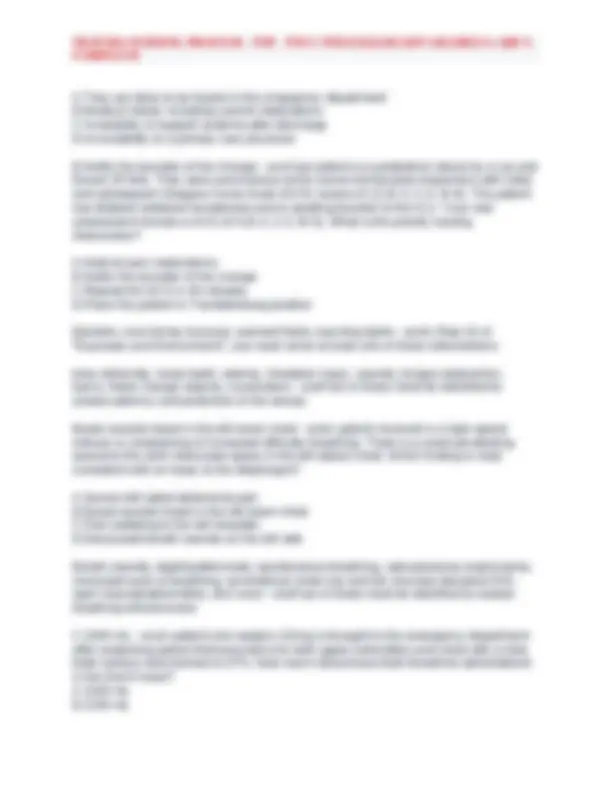
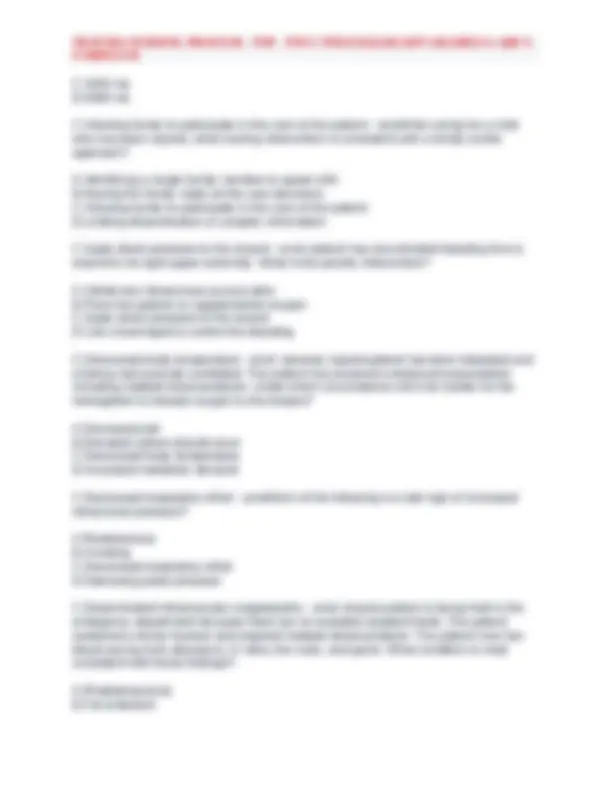
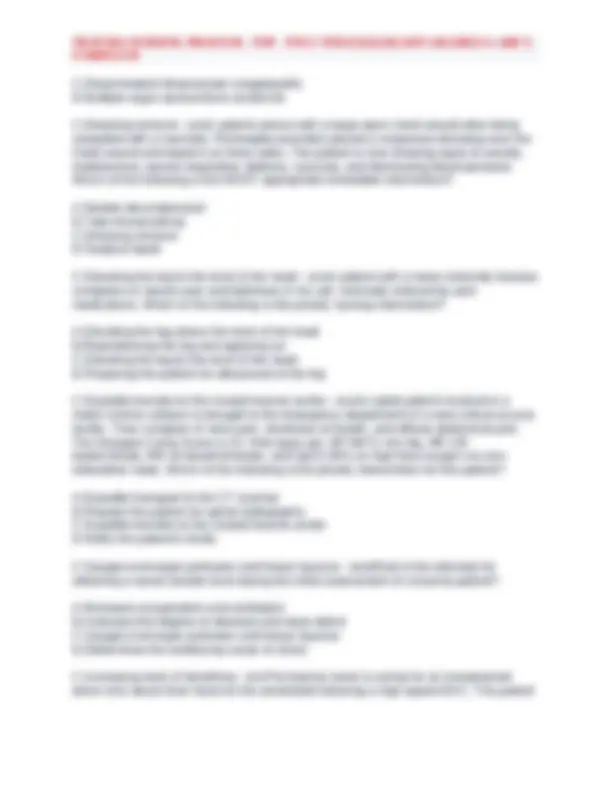
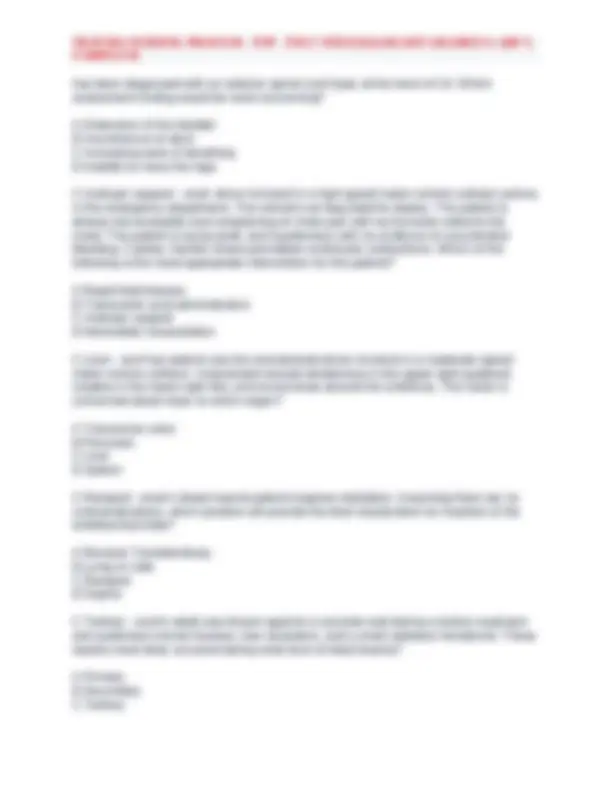
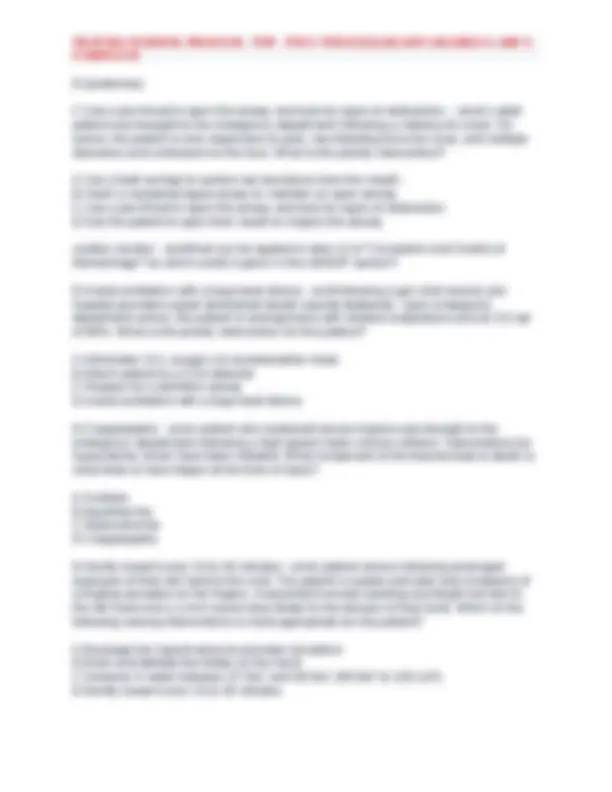
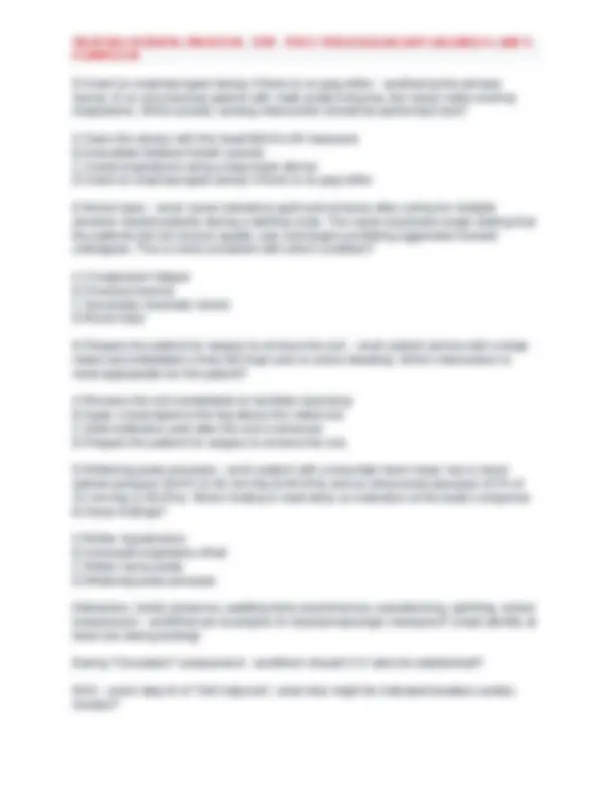
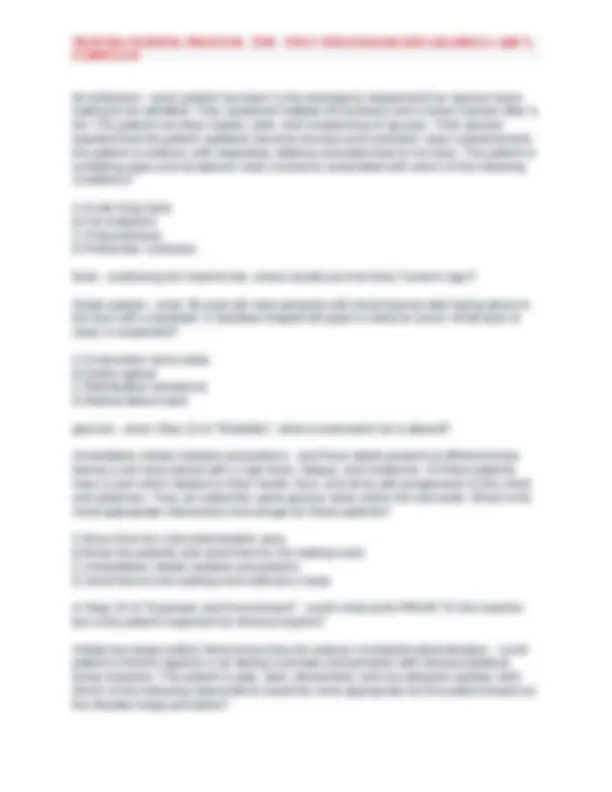
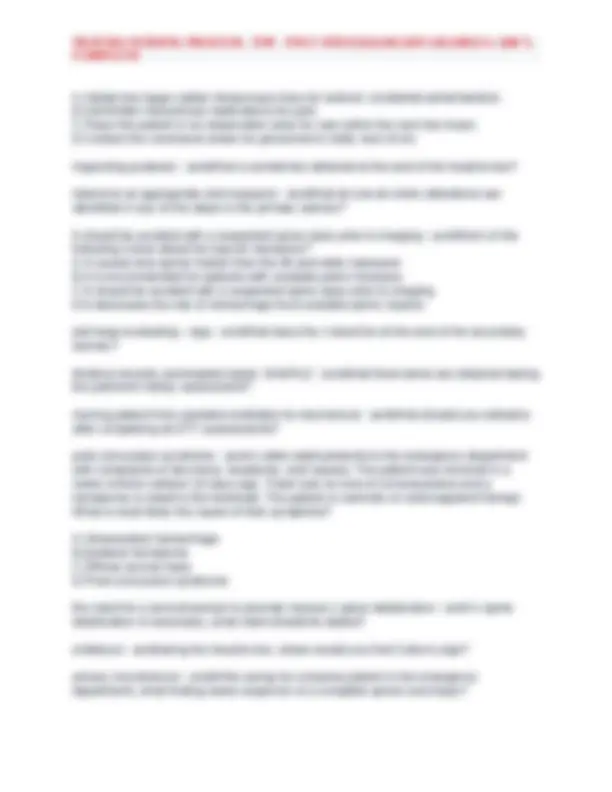
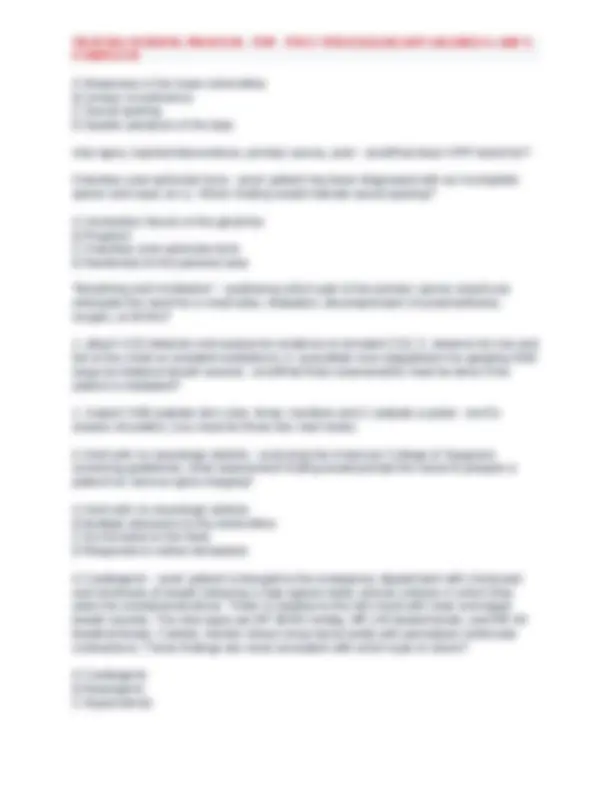
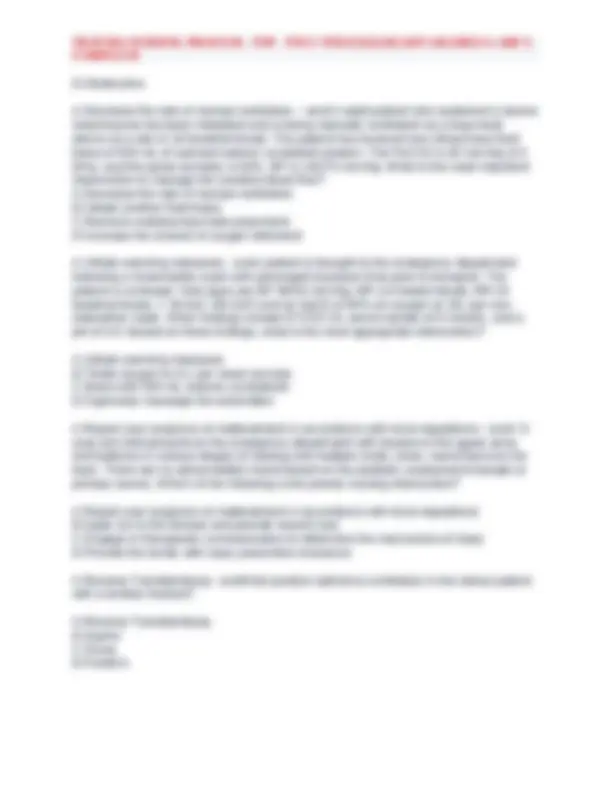
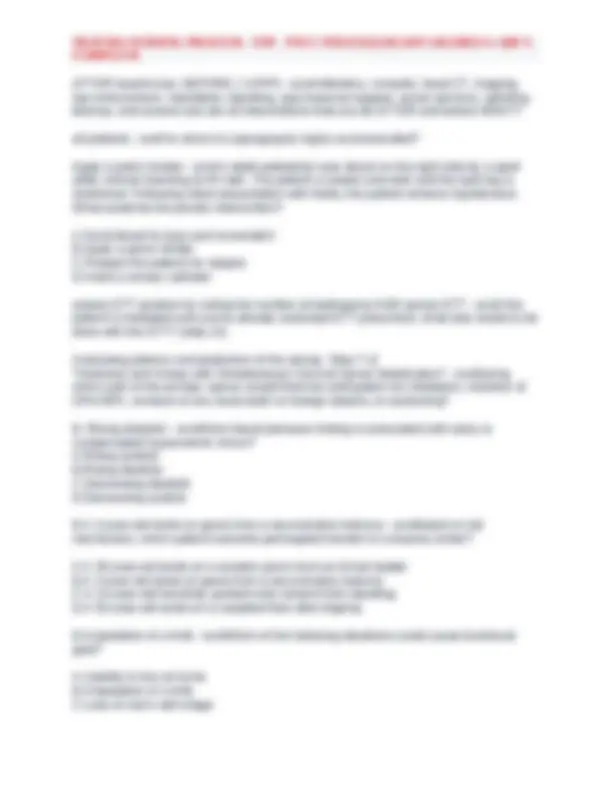
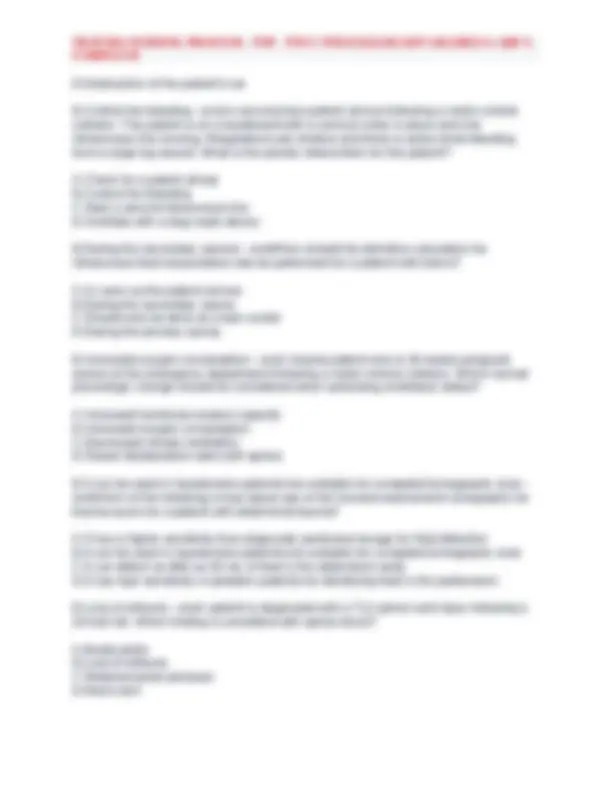
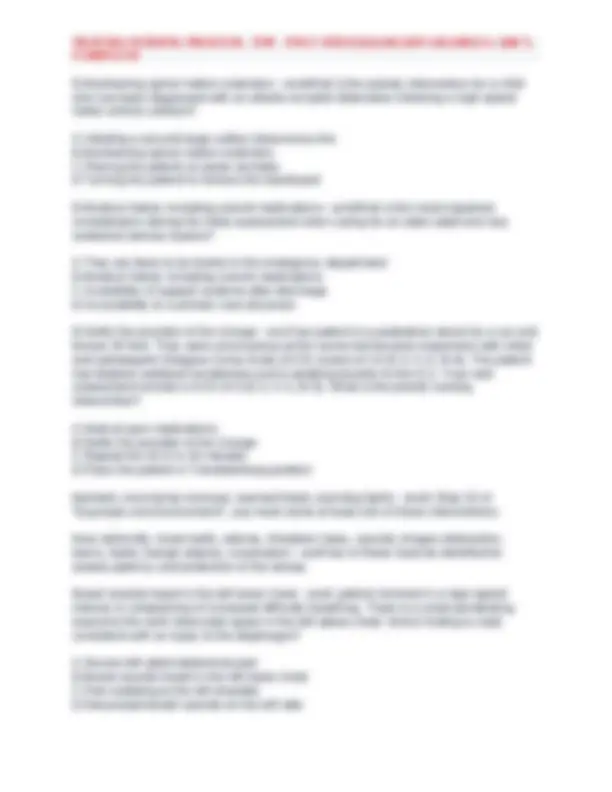
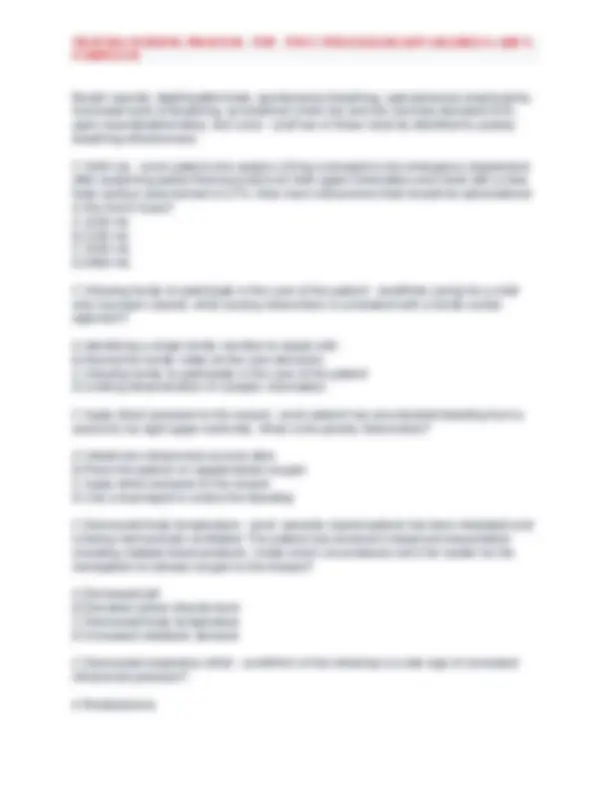


Study with the several resources on Docsity

Earn points by helping other students or get them with a premium plan


Prepare for your exams
Study with the several resources on Docsity

Earn points to download
Earn points by helping other students or get them with a premium plan
Community
Ask the community for help and clear up your study doubts
Discover the best universities in your country according to Docsity users
Free resources
Download our free guides on studying techniques, anxiety management strategies, and thesis advice from Docsity tutors
A comprehensive review of the normal physiologic changes to consider when assessing ventilatory status, focusing on increased oxygen consumption. It also discusses the use of the focused assessment sonography for trauma exam, its applications, and its sensitivity in various patient populations. Particularly useful for nursing students and healthcare professionals, offering valuable insights into trauma nursing process and tncc 9th edition.
Typology: Exams
1 / 133

This page cannot be seen from the preview
Don't miss anything!





























































































**A stands for ___ and ___. - ansalertness, airway **B stands for ___ and ___. - ansbreathing, ventilation **C stands for ___. - anscirculation **D stands for ___. - ansdisability E stands for ___. - ansexposure After all of the assessments, interventions, reassessments, etc. are done, what is the last thing to ask? - ans"Is there anything you would like to add at this time?" After how many breaths do you assess for the evidence of exhaled CO2? - ansAfter 5 to 6 breaths. After identifying potential interventions/diagnostics and completing your assessments and interventions, you should ask yourself what? - ans"What findings will you continue to reevaluate while the patient is in your care?" "Just keep re-evaluating" After the head-to-toe, the learner should summarize injuries identified throughout the scenario and ask themselves: - ans"What interventions or diagnostics can you anticipate for this patient?" Continue the TNP assuming the patient was intubated. 9-11 - ans9. If intubated, assess endotracheal tube placement
If a patient is intubated, you must state... - ansthe need to begin mechanical ventilation or continue assisted ventilation If alterations in oxygenation or EtCO2 are noted, interventions may include but are not limited to the following: - ans- Increase or decrease rate of assisted ventilation
step completion is not important. - ansFalse. Order of step completion is of critical importance. T/F: During the general impression, you can perform the assessment and interventions simultaneously when multiple team members are present. - ansTrue. T/F: Even if the patient is alert and can cooperate, you must demonstrate manual opening of the airway using the jaw-thrust maneuver. - ansFalse. When the patient is alert and can cooperate, it is acceptable to ask the patient to open their mouth to assess the airway. T/F: If the patient was deemed unresponsive in step 4, you do not need to assess level of alertness, avpu. - ansTrue General impression is step 4, and if you already know the patient is unresponsive, they won't be alert or responsive. T/F: It is acceptable to have one IV or IO site on a patient with altered circulatory status.
What are the 4 potential single-starred criteria? - ans- reassessment of primary survey interventions
Best verbal response (1-5) Best motor response (1-6) What is the first double-starred assessment? What step is it? - ansAlertness and AVPU are the first double-starred assessments. It is step 5**. What might need to be reprioritized during the general impression? Why? - ansYou may need to switch from ABCs to C-ABCs in the case of uncontrolled external hemorrhage. What might you ask yourself during preparation and triage? - ans"Is there any specific equipment that you would prepare?" What should be considered when applying ice to patients for comfort? - ansApplying ice to swollen areas may be appropriate but consider hypothermia risk for major trauma and very small pediatric patients. What should be considered when providing warmth? - ansWarmth may be appropriate, but consider burn risk. What should you ask yourself after completing all of your interventions and reassessments? - ansDoes this patient need to be transferred to another hospital, to surgery, or to critical care? What should you ask yourself when assessing for alertness, avpu? - ansIs the patient Alert, do they require a Verbal or Painful stimulus to respond, or are they Unresponsive? When alterations are identified during the assessment of airway patency and protection, you must ___ as appropriate and remember to ___. - ansintervene, reassess When assessing for alertness and airway, you must simultaneously ___________. - anscontinue cervical spinal stabilization When considering GU and how to monitor urinary output: - ans- Assess for contraindications for an indwelling urinary catheter
D.Responds to verbal stimulation A.Cardiogenic - ansA patient is brought to the emergency department with chest pain and shortness of breath following a high-speed motor vehicle collision in which they were the unrestrained driver. There is crepitus to the left chest with clear and equal breath sounds. The vital signs are BP 80/40 mmHg, HR 140 beats/minute, and RR 40 breaths/minute. Cardiac monitor shows sinus tachycardia with premature ventricular contractions. These findings are most consistent with which type of shock? A.Cardiogenic B.Neurogenic C.Hypovolemic D.Obstructive A.Decrease the rate of manual ventilation. - ansAn adult patient who sustained a severe head trauma has been intubated and is being manually ventilated via a bag-mask device at a rate of 18 breaths/minute. The patient has received one intravenous fluid bolus of 500 mL of warmed isotonic crystalloid solution. The PaCO2 is 30 mm Hg (4. kPa), and the pulse oximetry is 92%. BP is 142/70 mm Hg. What is the most important intervention to manage the cerebral blood flow? A.Decrease the rate of manual ventilation. B.Initiate another fluid bolus. C.Recheck endotracheal tube placement. D.Increase the amount of oxygen delivered. A.Initiate warming measures - ansA patient is brought to the emergency department following a snowmobile crash with prolonged exposure time prior to transport. The patient is confused. Vital signs are BP 96/54 mm Hg, HR 114 beats/minute, RR 24 breaths/minute, T 34.6oC (94.2oF) and an SpO2 of 90% on oxygen at 15L per non- rebreather mask. Other findings include ETCO2 24, serum lactate of 6 mmol/L, and a pH of 6.8. Based on these findings, what is the most appropriate intervention? A.Initiate warming measures B.Titrate oxygen to 6 L per nasal cannula C.Bolus with 500 mL isotonic crystalloids D.Vigorously massage the extremities A.Report your suspicion of maltreatment in accordance with local regulations - ansA 5- year-old child presents to the emergency department with bruises to the upper arms and buttocks in various stages of healing and multiple small, clean, round burns to the back. There are no abnormalities found based on the pediatric assessment triangle or primary survey. Which of the following is the priority nursing intervention? A.Report your suspicion of maltreatment in accordance with local regulations B.Apply ice to the bruises and provide wound care C.Engage in therapeutic communication to determine the mechanism of injury
D.Provide the family with injury prevention resources A.Reverse Trendelenburg - ansWhat position optimizes ventilation in the obese patient with a lumbar fracture? A.Reverse Trendelenburg B.Supine C.Prone D.Fowler's AFTER head-to-toe, BEFORE J (VIPP) - ansAntibiotics, consults, head CT, imaging, law enforcement, mandatory reporting, psychosocial support, social services, splinting, tetanus, and wound care are all interventions that you do AFTER and before WHAT? all patients - ansFor whom is capnography highly recommended? Apply a pelvic binder - ansAn adult pedestrian was struck on the right side by a sport utility vehicle traveling at 40 mph. The patient is awake and alert and the right leg is shortened. Following initial resuscitation with fluids, the patient remains hypotensive. What would be the priority intervention? A.Send blood for type and crossmatch B.Apply a pelvic binder C.Prepare the patient for surgery D.Insert a urinary catheter assess ETT position by noting the number at teeth/gums AND secure ETT - ansIf the patient is intubated and you've already assessed ETT placement, what else needs to be done with the ETT? (step 10) Assessing patency and protection of the airway, Step 7 of "Alertness and Airway with Simultaneous Cervical Spinal Stabilization" - ansDuring which part of the primary survey would there be anticipation for intubation, insertion of OPA/NPA, removal of any loose teeth or foreign objects, or suctioning? B. Rising diastolic - ansWhich blood pressure finding is associated with early or compensated hypovolemic shock? A.Rising systolic B.Rising diastolic C.Decreasing diastolic D.Decreasing systolic B.A 2-year-old lands on grass from a second-story balcony - ansBased on fall mechanism, which patient warrants prehospital transfer to a trauma center? A.A 35-year-old lands on a wooden porch from an 8-foot ladder
D.It has high sensitivity in pediatric patients for identifying fluid in the peritoneum B.Loss of reflexes - ansA patient is diagnosed with a T12 spinal cord injury following a 20-foot fall. Which finding is consistent with spinal shock? A.Bradycardia B.Loss of reflexes C.Widened pulse pressure D.Warm skin B.Maintaining spinal motion restriction - ansWhat is the priority intervention for a child who has been diagnosed with an atlanto-occipital dislocation following a high-speed motor vehicle collision? A.Initiating a second large caliber intravenous line B.Maintaining spinal motion restriction C.Placing the patient on pulse oximetry D.Turning the patient to remove the backboard B.Medical history including current medications - ansWhat is the most important consideration during the initial assessment when caring for an older adult who has sustained serious injuries? A.They are likely to be fearful in the emergency department B.Medical history including current medications C.Availability of support systems after discharge D.Accessibility to a primary care physician B.Notify the provider of the change - ansYour patient is a pedestrian struck by a car and thrown 35 feet. They were unconscious at the scene but became responsive with initial and subsequent Glasgow Coma Scale (GCS) scores of 13 (E-3, V-4, M-6). The patient has bilateral subdural hematomas and is awaiting transfer to the ICU. Your next assessment reveals a GCS of 9 (E-2, V-2, M-5). What is the priority nursing intervention? A.Hold all pain medications B.Notify the provider of the change C.Repeat the GCS in 30 minutes D.Place the patient in Trendelenburg position blankets, room temp increase, warmed fluids, warming lights - ansIn Step 16 of "Exposure and Environment", you must name at least one of these interventions: bony deformity, loose teeth, edema, inhalation injury, sounds, tongue obstruction, burns, fluids, foreign objects, vocalization - ansFour of these must be identified to assess patency and protection of the airway:
Bowel sounds heard in the left lower chest - ansA patient involved in a high-speed rollover is complaining of increased difficulty breathing. There is a small penetrating wound to the sixth intercostal space in the left lateral chest. Which finding is most consistent with an injury to the diaphragm? A.Severe left-sided abdominal pain B.Bowel sounds heard in the left lower chest C.Pain radiating to the left shoulder. D.Decreased breath sounds on the left side Breath sounds, depth/pattern/rate, spontaneous breathing, subcutaneous emphysema, increased work of breathing, symmetrical chest rise and fall, tracheal deviation/JVD, open wounds/deformities, skin color - ansFour of these must be identified to assess breathing effectiveness: C.3240 mL - ansA patient who weighs 120 kg is brought to the emergency department after sustaining partial thickness burns to both upper extremities and chest with a total body surface area burned of 27%. How much intravenous fluid should be administered in the first 8 hours? A.1620 mL B.2160 mL C.3240 mL D.6480 mL C.Allowing family to participate in the care of the patient - ansWhile caring for a child who has been injured, what nursing intervention is consistent with a family-center approach? A.Identifying a single family member to speak with B.Having the family make all the care decisions C.Allowing family to participate in the care of the patient D.Limiting dissemination of complex information C.Apply direct pressure to the wound - ansA patient has uncontrolled bleeding from a wound to his right upper extremity. What is the priority intervention? A.Initiate two intravenous access sites B.Place the patient on supplemental oxygen C.Apply direct pressure to the wound D.Use a tourniquet to control the bleeding C.Decreased body temperature - ansA severely injured patient has been intubated and is being mechanically ventilated. The patient has received a balanced resuscitation including multiple blood products. Under which circumstance will it be harder for the hemoglobin to release oxygen to the tissues?
C.Expedite transfer to the closest trauma center - ansAn adult patient involved in a motor vehicle collision is brought to the emergency department of a rural critical access facility. They complain of neck pain, shortness of breath, and diffuse abdominal pain. The Glasgow Coma Score is 15. Vital signs are: BP 98/71 mm Hg, HR 125 beats/minute, RR 26 breaths/minute, and SpO2 94% on high-flow oxygen via non- rebreather mask. Which of the following is the priority intervention for this patient? A.Expedite transport to the CT scanner B.Prepare the patient for spinal radiographs C.Expedite transfer to the closest trauma center D.Notify the patient's family C.Gauges end-organ perfusion and tissue hypoxia - ansWhat is the rationale for obtaining a serum lactate level during the initial assessment of a trauma patient? A.Measures oxygenation and ventilation B.Assesses the degree of alkalosis and base deficit C.Gauges end-organ perfusion and tissue hypoxia D.Determines the underlying cause of shock C.Increasing work of breathing - ansThe trauma nurse is caring for an unrestrained driver who struck their head on the windshield following a high-speed MVC. The patient has been diagnosed with an anterior spinal cord injury at the level of C6. Which assessment finding would be most concerning? A.Distension of the bladder B.Incontinence of stool C.Increasing work of breathing D.Inability to move the legs C.Inotropic support - ansA driver involved in a high-speed motor vehicle collision arrives in the emergency department. The vehicle's air-bag failed to deploy. The patient is drowsy but arousable and complaining of chest pain with ecchymosis noted to the chest. The patient is tachycardic and hypotensive with no evidence of uncontrolled bleeding. Cardiac monitor shows premature ventricular contractions. Which of the following is the most appropriate intervention for this patient? A.Rapid fluid boluses B.Tranexamic acid administration C.Inotropic support D.Hemostatic resuscitation C.Liver - ansYour patient was the unrestrained driver involved in a moderate speed motor vehicle collision. Assessment reveals tenderness in the upper right quadrant, crepitus in the lower right ribs, and ecchymosis around the umbilicus. The nurse is concerned about injury to which organ?
A.Transverse colon B.Pancreas C.Liver D.Spleen C.Ramped - ansAn obese trauma patient requires intubation. Assuming there are no contraindications, which position will provide the best visualization for insertion of the endotracheal tube? A.Reverse Trendelenburg B.Lying on side C.Ramped D.Supine C.Tertiary - ansAn adult was thrown against a concrete wall during a factory explosion and sustained a femur fracture, liver laceration, and a small subdural hematoma. These injuries most likely occurred during what level of blast trauma? A.Primary B.Secondary C.Tertiary D.Quaternary C.Use a jaw thrust to open the airway and look for signs of obstruction. - ansAn adult patient was brought to the emergency department following a motorcycle crash. On arrival, the patient is only responsive to pain, has bleeding from the nose, and multiple abrasions and contusions to the face. What is the priority intervention? A.Use a bulb syringe to suction out secretions from the mouth. B.Insert a nasopharyngeal airway to maintain an open airway. C.Use a jaw thrust to open the airway and look for signs of obstruction. D.Ask the patient to open their mouth to inspect the airway. cardiac monitor - ansWhat can be applied in step 12 of "Circulation and Control of Hemorrhage" for which credit is given in the LMNOP section? D.Assist ventilation with a bag-mask device - ansFollowing a gun shot wound, pre- hospital providers report diminished breath sounds bilaterally. Upon emergency department arrival, the patient is unresponsive with shallow respirations and an O2 sat of 88%. What is the priority intervention for this patient? A.Administer 15 L oxygen via nonrebreather mask B.Attach patient to a CO2 detector C.Prepare for a definitive airway D.Assist ventilation with a bag-mask device
B.Apply a tourniquet to the leg above the metal rod. C.Hold antibiotics until after the rod is removed. D.Prepare the patient for surgery to remove the rod. D.Widening pulse pressure - ansA patient with a traumatic brain injury has a mean arterial pressure (MAP) of 65 mm Hg (8.66 kPa) and an intracranial pressure (ICP) of 22 mm Hg (2.93 kPa). Which finding is most likely an indication of the body's response to these findings? A.Reflex hypotension B.Increased respiratory effort C.Reflex tachycardia D.Widening pulse pressure Distraction, family presence, padding bony prominences, repositioning, splinting, verbal reassurance - ansWhat are examples of nonpharmacologic measures? (must identify at least one during testing) During "Circulation" assessment - ansWhen should 2 IV sites be established? EKG - ansIn step M of "Get Adjuncts", what else might be indicated besides cardiac monitor? fat embolism - ansA patient has been in the emergency department for several hours waiting to be admitted. They sustained multiple rib fractures and a femur fracture after a fall. The patient has been awake, alert, and complaining of leg pain. Their spouse reported that the patient suddenly became anxious and confused. Upon reassessment, the patient is restless, with respiratory distress and petechiae to his neck. The patient is exhibiting signs and symptoms most commonly associated with which of the following conditions? A.Acute lung injury B.Fat embolism C.Pneumothorax D.Pulmonary contusion flank - ansDuring the head-to-toe, where would you find Grey-Turner's sign? Globe rupture - ansA 35-year-old male presents with facial trauma after being struck in the face with a baseball. A teardrop-shaped left pupil is noted on exam. What type of injury is suspected? A.Oculomotor nerve palsy B.Globe rupture C.Retrobulbar hematoma D.Retinal detachment
glucose - ansIn Step 13 of "Disability", what is assessed if pt is altered? Immediately initiate isolation precautions - ansThree adults present at different times during a one-hour period with a high fever, fatigue, and headache. All three patients have a rash which started on their mouth, face, and arms with progression to the chest and abdomen. They all visited the same grocery store within the last week. What is the most appropriate intervention from triage for these patients? A.Move them to a decontamination area B.Mask the patients and send them to the waiting room C.Immediately initiate isolation precautions D.Send them to the waiting room without a mask In Step 15 of "Exposure and Environment" - ansAt what point PRIOR TO the head-to- toe is the patient inspected for obvious injuries? Initiate two large-caliber intravenous lines for isotonic crystalloid administration. - ansA patient is thrown against a car during a tornado and presents with obvious bilateral femur fractures. The patient is pale, alert, disoriented, and has delayed capillary refill. Which of the following interventions would be most appropriate for this patient based on the disaster triage principles? A.Initiate two large-caliber intravenous lines for isotonic crystalloid administration. B.Administer intravenous medications for pain. C.Place the patient in an observation area for care within the next few hours. D.Contact the command center for personnel to notify next of kin. inspecting posterior - ansWhat is sometimes deferred at the end of the head-to-toe? intervene as appropriate and reassess - ansWhat do you do when alterations are identified in any of the steps in the primary survery? It should be avoided with a suspected spine injury prior to imaging - ansWhich of the following is true about the log-roll maneuver? A.It causes less spinal motion than the lift-and-slide maneuver B.It is recommended for patients with unstable pelvic fractures C.It should be avoided with a suspected spine injury prior to imaging D.It decreases the risk of hemorrhage from unstable pelvic injuries just keep evaluating - vipp - ansWhat does the J stand for at the end of the secondary survery? Medical records, prehospital report, SAMPLE - ansWhat three items are obtained during the pertinent history assessment?